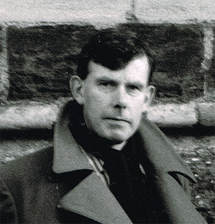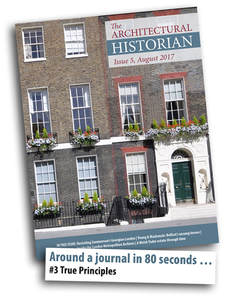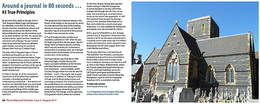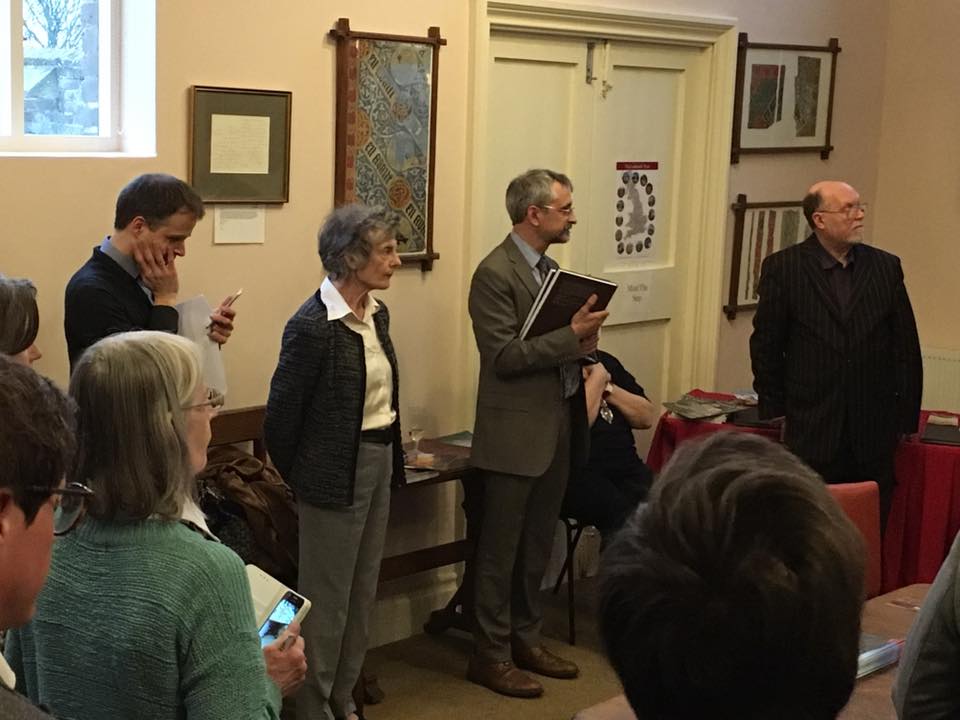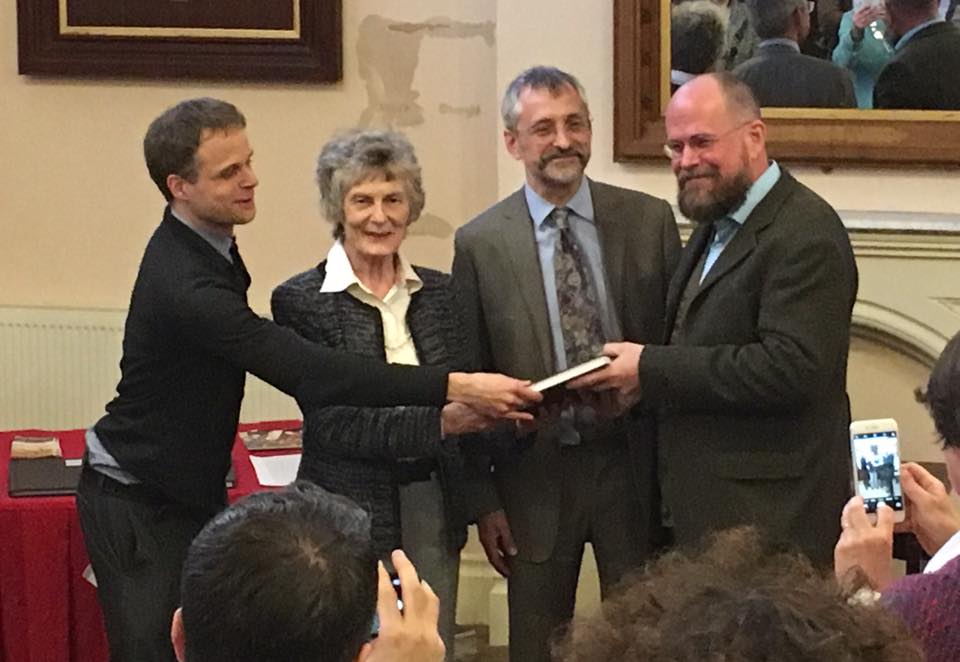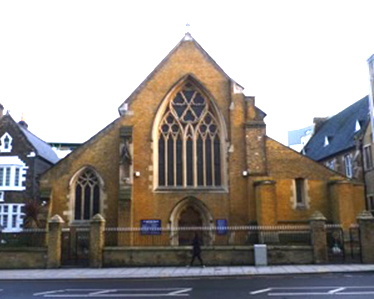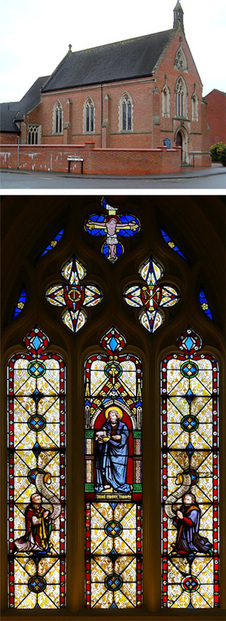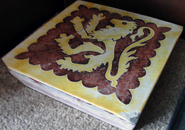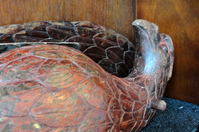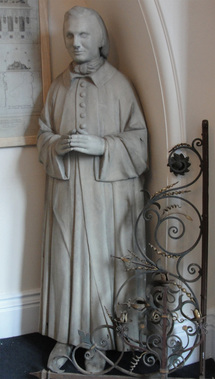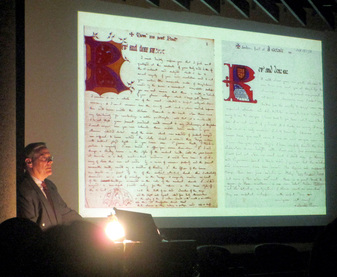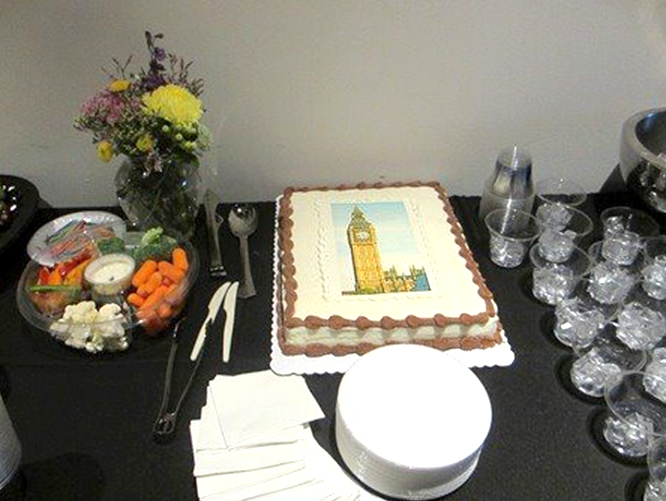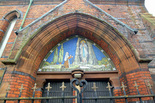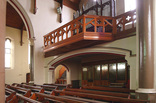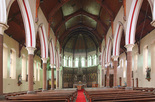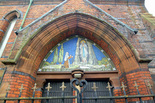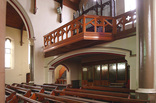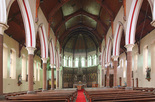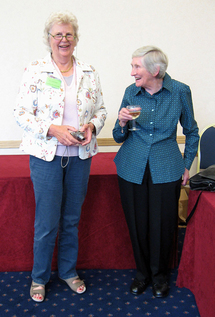News Archive |
2019
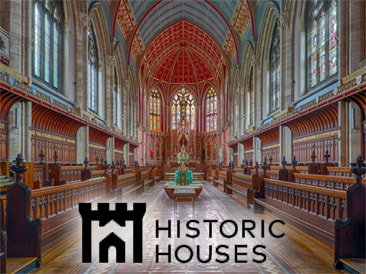
Ushaw College now part of Historic Houses
Historic Houses, who represent the UK's largest collection of independently owned historic houses and gardens, have included Pugin's Ushaw College to their properties. The group oversees over 1,600 buildings and ensures these historic homes stay alive and accessible for generations to come. Their website states that they "advise owners on anything from rising damp to hosting festivals, and we lobby government on their behalf. We award those houses that have completed exceptional restorations, have wonderful gardens, and work tirelessly to excel in educational innovation. And we work to further research into historic houses and their collections."
Ushaw holds the largest collection of the Pugin family Gothic Revival architecture in the UK. Augustus Welby Northmore Pugin (1812-1852), famous for his work on the Houses of Parliament, was involved with Ushaw's building expansion from the 1840s to his death. Consequently, his sons Edward and Peter Paul Pugin both carried on his legacy and designed chapels, a museum, infirmary, dormitory and Junior School for the site. As a new addition, Ushaw College will begin admitting Historic Houses members for free from 2020. To find out more about your visit, head to the Historic Houses website HERE.
Historic Houses, who represent the UK's largest collection of independently owned historic houses and gardens, have included Pugin's Ushaw College to their properties. The group oversees over 1,600 buildings and ensures these historic homes stay alive and accessible for generations to come. Their website states that they "advise owners on anything from rising damp to hosting festivals, and we lobby government on their behalf. We award those houses that have completed exceptional restorations, have wonderful gardens, and work tirelessly to excel in educational innovation. And we work to further research into historic houses and their collections."
Ushaw holds the largest collection of the Pugin family Gothic Revival architecture in the UK. Augustus Welby Northmore Pugin (1812-1852), famous for his work on the Houses of Parliament, was involved with Ushaw's building expansion from the 1840s to his death. Consequently, his sons Edward and Peter Paul Pugin both carried on his legacy and designed chapels, a museum, infirmary, dormitory and Junior School for the site. As a new addition, Ushaw College will begin admitting Historic Houses members for free from 2020. To find out more about your visit, head to the Historic Houses website HERE.
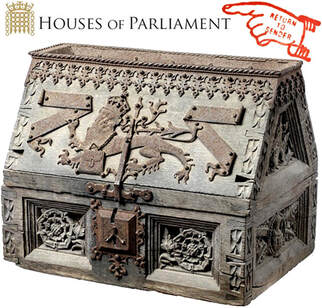
Pugin's Parliamentary letter box "Returned to Sender"
We’ve previously mentioned a wooden letter box that was mysteriously discovered in a farmhouse. We can now update on the interesting journey this item has taken and its arrival at it's new home. In late September the box was sold at auction where it was purchased for £4,200 (well over the estimated price) by the Palace of Westminster. We are told the item comes with no supporting documentation and has been “in private family ownership since the early 20th century or before.” In their newsletter, The Society of Antiquaries reports that “perhaps it was taken home by someone in Westminster when a replacement post-box system was introduced. Research, we are told, continues.” In a press release, Mark Collins, Archivist and Historian for the Houses of Parliament, says that he has located correspondence between Charles Barry and A W Pugin which discuss a letter box and feels “there is good reason to regard the recently discovered box as one of those referred to in this letter.” Although only one box has been found, Collins goes on to note that there were most likely two – one for the House of Lords, the other for the Commons. Auctioners Mellors & Kirk note that although “now much obscured by rust… the very finely chiselled mounts are consistent with the work of John Hardman & Co, Birmingham, and the [oak] box with Frederick Crace & Son, London.” Given its age and where it has been stored, the letter box is in very good condition and, following conservation work, will be added to Parliament’s Historic Furniture and Decorative Arts collection and placed on public display.
We’ve previously mentioned a wooden letter box that was mysteriously discovered in a farmhouse. We can now update on the interesting journey this item has taken and its arrival at it's new home. In late September the box was sold at auction where it was purchased for £4,200 (well over the estimated price) by the Palace of Westminster. We are told the item comes with no supporting documentation and has been “in private family ownership since the early 20th century or before.” In their newsletter, The Society of Antiquaries reports that “perhaps it was taken home by someone in Westminster when a replacement post-box system was introduced. Research, we are told, continues.” In a press release, Mark Collins, Archivist and Historian for the Houses of Parliament, says that he has located correspondence between Charles Barry and A W Pugin which discuss a letter box and feels “there is good reason to regard the recently discovered box as one of those referred to in this letter.” Although only one box has been found, Collins goes on to note that there were most likely two – one for the House of Lords, the other for the Commons. Auctioners Mellors & Kirk note that although “now much obscured by rust… the very finely chiselled mounts are consistent with the work of John Hardman & Co, Birmingham, and the [oak] box with Frederick Crace & Son, London.” Given its age and where it has been stored, the letter box is in very good condition and, following conservation work, will be added to Parliament’s Historic Furniture and Decorative Arts collection and placed on public display.
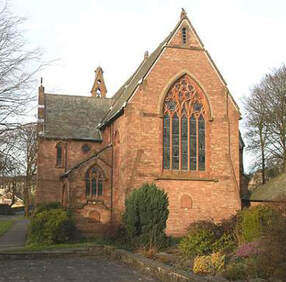
Congregation raising funds to save EW Pugin’s Our Lady and St Michael in Workington
The church of Our Lady Star of the Sea and St Michael in Workington, designed by Edward Pugin in 1876, has been placed on Historic England’s 2019 Heritage at Risk Register. To address the £1 million repair work, members of the congregation have established the Workington Stella Maris group and are hoping to involve the larger community in its fundraising efforts. Chair John Garner notes that the church is “desperate for a local funder and for the community to get involved” to address serious problems to the structure including sandstone erosion, delamination, a crack in the east end, re-roofing, work to the baptistery and entrance, and the bowing out of walls from the transcept to the north. The Cumberland News and Star reports that the church has applied to the heritage lottery fund without success. Garner states that “if we don’t invest we’ll end up with a ruin” and “if it’s gone it’s gone forever. We are working to protect the church for this and future generations. It is a community asset.” The church will hold a Christmas market on November 23, more details of which can be found HERE, along with updates on the restoration appeal.
The church of Our Lady Star of the Sea and St Michael in Workington, designed by Edward Pugin in 1876, has been placed on Historic England’s 2019 Heritage at Risk Register. To address the £1 million repair work, members of the congregation have established the Workington Stella Maris group and are hoping to involve the larger community in its fundraising efforts. Chair John Garner notes that the church is “desperate for a local funder and for the community to get involved” to address serious problems to the structure including sandstone erosion, delamination, a crack in the east end, re-roofing, work to the baptistery and entrance, and the bowing out of walls from the transcept to the north. The Cumberland News and Star reports that the church has applied to the heritage lottery fund without success. Garner states that “if we don’t invest we’ll end up with a ruin” and “if it’s gone it’s gone forever. We are working to protect the church for this and future generations. It is a community asset.” The church will hold a Christmas market on November 23, more details of which can be found HERE, along with updates on the restoration appeal.
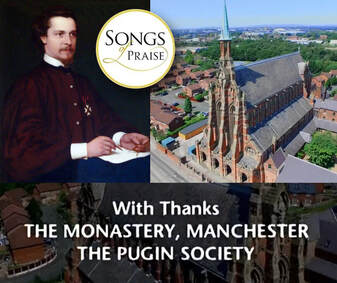
Edward Pugin's Gorton Monastery featured on Songs of Praise
The latest installment of Songs of Praise was broadcast from the Church and Friary of St Francis, otherwise known as Gorton Monastery. Designed by Edward Pugin and completed in 1872, the Franciscan friary in Manchester was in poor condition and was placed on the World Monuments Fund Watch List of the most endangered sites in the world. Following a £6 million restoration programme spearheaded by Elaine Griffiths, CEO of The Monastery of St Francis and Gorton Trust, the building was reopened in 2007. The episode can be viewed within the UK on the BBC HERE. Be sure to watch the credits as the Pugin Society is thanked for our help.
The latest installment of Songs of Praise was broadcast from the Church and Friary of St Francis, otherwise known as Gorton Monastery. Designed by Edward Pugin and completed in 1872, the Franciscan friary in Manchester was in poor condition and was placed on the World Monuments Fund Watch List of the most endangered sites in the world. Following a £6 million restoration programme spearheaded by Elaine Griffiths, CEO of The Monastery of St Francis and Gorton Trust, the building was reopened in 2007. The episode can be viewed within the UK on the BBC HERE. Be sure to watch the credits as the Pugin Society is thanked for our help.
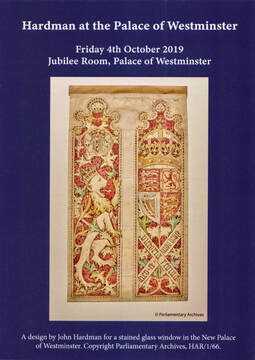
Hardman event at the Palace of Westminster a success
The symposium on Hardman and Pugin’s work at the new Houses of Parliament was held on October 4 and has garnered much praise. This Society only programme featured three speakers who covered various aspects of the Pugin-Hardman collaboration. This included Neil Phillips, former owner of John Hardman & Co., whose talk Hardman to the Rescue: from past to present, gave an introduction to the collaboration and an overview of working in the Hardman Studios in the more recent past; Jamie Jacobs, PhD student at the University of Kent whose talk “Gothic labourers for the present day”: Pugin’s collaboration with John Hardman examined how Pugin’s approach to fabrication and design was adopted and adapted for the realities of producing metalwork with Hardman; and Dr Jim Cheshire, University of Lincoln, whose talk Glazing the New Palace of Westminster: Debates, Dynamics and Glass Painters explored how the windows at the Palace related to debates about stained glass design in the 1840s and 1850s. Dr Mark Collins of the Palace of Westminster was meant to give the talk Hardman from the archives but he was unavailable due to illness and the talk and following tour were ably given in his absence by symposium convener Emily Spary of the Parliamentary Restoration and Renewal team.
For a more thorough and lively overview of the conference, we recommend you visit the website of Dr Grace Lees-Maffei, Professor of Design History at the University of Hertfordshire, found HERE. As a student of the late Clive Wainwright Lees-Maffei is well poised to assess the day’s gathering and offer a critical commentary on what she regards as a successful and engaging event. She concludes by stating “I am now very glad to finally be a member of the Pugin Society and on the basis of this symposium and tour, I can highly recommend membership to anyone with an interest in nineteenth-century design.” We cannot agree more.
The symposium on Hardman and Pugin’s work at the new Houses of Parliament was held on October 4 and has garnered much praise. This Society only programme featured three speakers who covered various aspects of the Pugin-Hardman collaboration. This included Neil Phillips, former owner of John Hardman & Co., whose talk Hardman to the Rescue: from past to present, gave an introduction to the collaboration and an overview of working in the Hardman Studios in the more recent past; Jamie Jacobs, PhD student at the University of Kent whose talk “Gothic labourers for the present day”: Pugin’s collaboration with John Hardman examined how Pugin’s approach to fabrication and design was adopted and adapted for the realities of producing metalwork with Hardman; and Dr Jim Cheshire, University of Lincoln, whose talk Glazing the New Palace of Westminster: Debates, Dynamics and Glass Painters explored how the windows at the Palace related to debates about stained glass design in the 1840s and 1850s. Dr Mark Collins of the Palace of Westminster was meant to give the talk Hardman from the archives but he was unavailable due to illness and the talk and following tour were ably given in his absence by symposium convener Emily Spary of the Parliamentary Restoration and Renewal team.
For a more thorough and lively overview of the conference, we recommend you visit the website of Dr Grace Lees-Maffei, Professor of Design History at the University of Hertfordshire, found HERE. As a student of the late Clive Wainwright Lees-Maffei is well poised to assess the day’s gathering and offer a critical commentary on what she regards as a successful and engaging event. She concludes by stating “I am now very glad to finally be a member of the Pugin Society and on the basis of this symposium and tour, I can highly recommend membership to anyone with an interest in nineteenth-century design.” We cannot agree more.
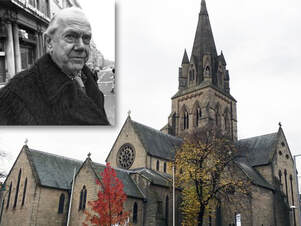
St Barnabas Cathedral, Nottingham, celebrates its famous convert
As part of its 175th anniversary celebrations AWN Pugin’s St Barnabas Cathedral, Nottingham, is holding a study afternoon on the writer Graham Greene, who became a Catholic there in 1926. Faith, Nottingham and Graham Greene on Saturday October 19, from 2-7pm, will include novelists Creina Mansfield and David Belbin and the playwright Michael Eaton. It will be followed by an optional tour of the cathedral.
When he was 21 Greene spent several months in the city working as a sub-editor on the Nottingham Journal and visited what he later described, in his autobiography, A Sort of Life, “the sooty neo-Gothic cathedral.” “It possessed for me a certain gloomy power because it represented the inconceivable and incredible,” he said. But following twice-weekly instruction from the cathedral administrator, Father George Trollope, he was received into the church in February 1926 “with the only witness of my baptism a woman who had been dusting the chairs.”
St Barnabas was completed in 1844 at a cost of £20,000 of which £7,000 was provided by the Earl of Shrewsbury. Pugin was unable to attend the two-day consecration ceremony because he was arranging the funeral of his second wife, Louisa who had died on August 22nd. A report of the opening in the Illustrated London News described St Barnabas as “the largest Catholic church completed in this country since the reformation”. To book a ticket for the event email [email protected] and click HERE for more details.
As part of its 175th anniversary celebrations AWN Pugin’s St Barnabas Cathedral, Nottingham, is holding a study afternoon on the writer Graham Greene, who became a Catholic there in 1926. Faith, Nottingham and Graham Greene on Saturday October 19, from 2-7pm, will include novelists Creina Mansfield and David Belbin and the playwright Michael Eaton. It will be followed by an optional tour of the cathedral.
When he was 21 Greene spent several months in the city working as a sub-editor on the Nottingham Journal and visited what he later described, in his autobiography, A Sort of Life, “the sooty neo-Gothic cathedral.” “It possessed for me a certain gloomy power because it represented the inconceivable and incredible,” he said. But following twice-weekly instruction from the cathedral administrator, Father George Trollope, he was received into the church in February 1926 “with the only witness of my baptism a woman who had been dusting the chairs.”
St Barnabas was completed in 1844 at a cost of £20,000 of which £7,000 was provided by the Earl of Shrewsbury. Pugin was unable to attend the two-day consecration ceremony because he was arranging the funeral of his second wife, Louisa who had died on August 22nd. A report of the opening in the Illustrated London News described St Barnabas as “the largest Catholic church completed in this country since the reformation”. To book a ticket for the event email [email protected] and click HERE for more details.
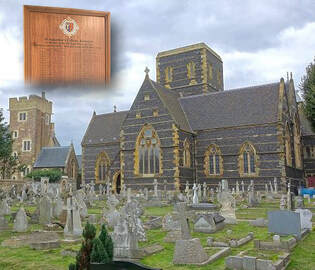
War memorial dedicated at St Augustine’s church in Ramsgate
A war memorial plaque listing the names of past students of St Augustine’s College and Abbey School who died in conflict was unveiled by Lt. Col. Paddy Williams, a member of the Household Cavalry Mounted Regiment and former pupil at St Augustine’s College, at a ceremony on September 28.
This is not the first war memorial, with the original dedicated to World War One erected above the entrance to St Augustine’s College chapel in 1919. The chapel was built by Peter Paul Pugin, St Augustine’s first registered pupil, and the school building (St Gregory’s) by Edward Pugin. Both structures were both demolished after the school’s relocation in 1971 and the memorial was lost at this time. The Second World War memorial was put in storage after the school closed down in 1995. The new memorial includes a roll of honour memorialising those students of St Augustine’s who were killed in the World Wars, including Michael Thunder, AWN Pugin’s grandson. The plaque has been funded by generous donations from Old Augustinians.
A war memorial plaque listing the names of past students of St Augustine’s College and Abbey School who died in conflict was unveiled by Lt. Col. Paddy Williams, a member of the Household Cavalry Mounted Regiment and former pupil at St Augustine’s College, at a ceremony on September 28.
This is not the first war memorial, with the original dedicated to World War One erected above the entrance to St Augustine’s College chapel in 1919. The chapel was built by Peter Paul Pugin, St Augustine’s first registered pupil, and the school building (St Gregory’s) by Edward Pugin. Both structures were both demolished after the school’s relocation in 1971 and the memorial was lost at this time. The Second World War memorial was put in storage after the school closed down in 1995. The new memorial includes a roll of honour memorialising those students of St Augustine’s who were killed in the World Wars, including Michael Thunder, AWN Pugin’s grandson. The plaque has been funded by generous donations from Old Augustinians.
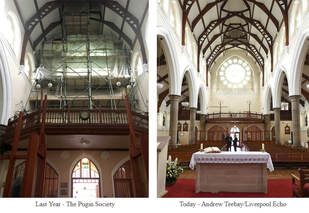
Restoration efforts at Liverpool's Our Lady of Reconciliation now complete
Those of you who joined us on last year's study tour will remember our visit to Edward Pugin's Grade II listed Our Lady of Reconciliation de la Salette, 1859-60. During our visit, we learned that the church was undergoing serious structural repairs to secure the opposing walls from bulging out due to damage inflicted by the careless installation of a bell-cote. We share a news story from the Liverpool Echo HERE, discussing the restoration and giving views of the interior. For comparison, we show our photo of the interior from our trip last year with the completed works. We're sure you will join us in congratulating the church of Our Lady on a job well done.
Those of you who joined us on last year's study tour will remember our visit to Edward Pugin's Grade II listed Our Lady of Reconciliation de la Salette, 1859-60. During our visit, we learned that the church was undergoing serious structural repairs to secure the opposing walls from bulging out due to damage inflicted by the careless installation of a bell-cote. We share a news story from the Liverpool Echo HERE, discussing the restoration and giving views of the interior. For comparison, we show our photo of the interior from our trip last year with the completed works. We're sure you will join us in congratulating the church of Our Lady on a job well done.
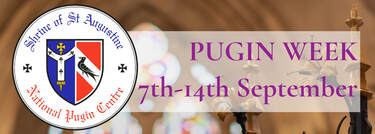
Pugin Week September 7 - 14, 2019 Events Announced
The Shrine of St Augustine and the National Pugin Centre in Ramsgate have announced details of their annual week of events to celebrate Augustus Pugin.
Highlights include:
• A boat trip to the Goodwin Sands – where Pugin used to rescue shipwrecked sailors and salvage cargo from their ships.
• Unveiling of the replica of the Pugin Altar frontal from the Jesuit Church in Farm Street with drinks reception and music.
• Talk about the “Anglican Pugin” (R.H. Carpenter) and his greatest work, the Chapel of Lancing College.
• Walk from Canterbury to Ramsgate, Saturday 7th.
• Musical events including Faure’s Requiem from scratch Saturday 14th and an opportunity to learn Gregorian Chant.
We may be biased, but we highly recommend the lecture on Wednesday, 11th September, given by Catriona Blaker, local Pugin scholar and co-founder of the Pugin Society, who will be talking about Herbert Minton, designer of the encaustic tiles in St Augustine's and the Houses of Parliament. For the full schedule, click HERE.
The Shrine of St Augustine and the National Pugin Centre in Ramsgate have announced details of their annual week of events to celebrate Augustus Pugin.
Highlights include:
• A boat trip to the Goodwin Sands – where Pugin used to rescue shipwrecked sailors and salvage cargo from their ships.
• Unveiling of the replica of the Pugin Altar frontal from the Jesuit Church in Farm Street with drinks reception and music.
• Talk about the “Anglican Pugin” (R.H. Carpenter) and his greatest work, the Chapel of Lancing College.
• Walk from Canterbury to Ramsgate, Saturday 7th.
• Musical events including Faure’s Requiem from scratch Saturday 14th and an opportunity to learn Gregorian Chant.
We may be biased, but we highly recommend the lecture on Wednesday, 11th September, given by Catriona Blaker, local Pugin scholar and co-founder of the Pugin Society, who will be talking about Herbert Minton, designer of the encaustic tiles in St Augustine's and the Houses of Parliament. For the full schedule, click HERE.
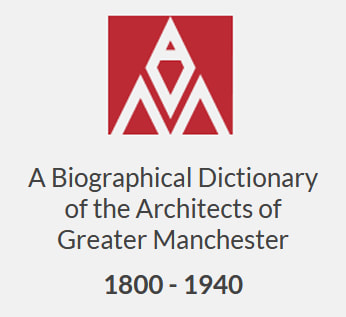
The Biographical Dictionary of Greater Manchester Architects now available online
The Manchester Group of the Victorian Society has announced that the Biographical Dictionary of Greater Manchester Architects is now freely available online. Created under the auspices of the Manchester Group of the Victorian Society to mark its jubilee, Manchester Victorian Architects (DGMA) is a database providing biographical information and details of commissions awarded for all architects known to have been born, trained, lived, or worked in Greater Manchester between 1800 and 1940. Searchable by name or location of architect, practice, or building, architects based in the Greater Manchester area have their known works catalogued as fully as possible and details of architects based elsewhere in the UK are included insofar as their commissions relate to the Greater Manchester area. The database currently provides details of over 1,000 architects, 400 partnerships and 10,000 buildings, including AWN Pugin's Church of St Wilfrid in Hulme and nine buildings by Edward Pugin. We congratulate the Manchester Group of the Victorian Society on the completion of this valuable resource and thank them for sharing it with us. You can access the database HERE.
The Manchester Group of the Victorian Society has announced that the Biographical Dictionary of Greater Manchester Architects is now freely available online. Created under the auspices of the Manchester Group of the Victorian Society to mark its jubilee, Manchester Victorian Architects (DGMA) is a database providing biographical information and details of commissions awarded for all architects known to have been born, trained, lived, or worked in Greater Manchester between 1800 and 1940. Searchable by name or location of architect, practice, or building, architects based in the Greater Manchester area have their known works catalogued as fully as possible and details of architects based elsewhere in the UK are included insofar as their commissions relate to the Greater Manchester area. The database currently provides details of over 1,000 architects, 400 partnerships and 10,000 buildings, including AWN Pugin's Church of St Wilfrid in Hulme and nine buildings by Edward Pugin. We congratulate the Manchester Group of the Victorian Society on the completion of this valuable resource and thank them for sharing it with us. You can access the database HERE.

Eileen Allen, Pugin's great granddaughter, passes away
We received word from a relative that Eileen Thunder Allen, great granddaughter of AWN Pugin, passed away last year at the ripe age of 100. Her granddaughter writes how "I recall how she spoke fondly of her family's history. I also remember a very large book about Pugin that had a permanent spot in her living room." To follow the lineage, AWN Pugin & Jane Knill (third wife, 1825-1909) > Margaret Pugin (daughter, 1849-1884) & George Thunder (second husband) > James A Thunder (AWN’s grandson, 1879-1954) & Gertrude Buckley > Eileen Gertrude Thunder Allen (AWN’s great granddaughter, September 29, 1917 - March 14, 2018). Eileen leaves behind 8 children, 16 grandchildren and 10 greatgrandchildren to continue Pugin's legacy. A full obituary can be found HERE.
We received word from a relative that Eileen Thunder Allen, great granddaughter of AWN Pugin, passed away last year at the ripe age of 100. Her granddaughter writes how "I recall how she spoke fondly of her family's history. I also remember a very large book about Pugin that had a permanent spot in her living room." To follow the lineage, AWN Pugin & Jane Knill (third wife, 1825-1909) > Margaret Pugin (daughter, 1849-1884) & George Thunder (second husband) > James A Thunder (AWN’s grandson, 1879-1954) & Gertrude Buckley > Eileen Gertrude Thunder Allen (AWN’s great granddaughter, September 29, 1917 - March 14, 2018). Eileen leaves behind 8 children, 16 grandchildren and 10 greatgrandchildren to continue Pugin's legacy. A full obituary can be found HERE.
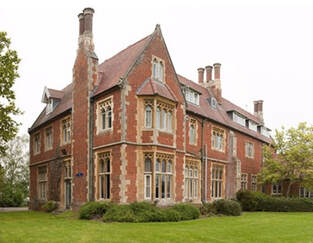
Historic England designates Pugin’s Wilburton Manor Grade II
Wilburton Manor in East Cambridgeshire was completed in 1851 to the designs of AWN Pugin and built by George Myers for the Pell family, the local landowners. The building is one of Pugin’s ‘pin wheel’ houses which comprised principal rooms on the ground floor radiating off a central stair hall and orientated at 90 degrees from each other. Principal bedrooms were located around the stair hall on the first floor. Service areas and servant accommodation was provided away from the principal spaces and at Wilburton is accessed through a doorway under the main stair. Wilburton Manor has undergone some alteration through its conversion and use as a school and its listing as Grade II reflects these changes.
Click HERE to view Historic England's listing.
Wilburton Manor in East Cambridgeshire was completed in 1851 to the designs of AWN Pugin and built by George Myers for the Pell family, the local landowners. The building is one of Pugin’s ‘pin wheel’ houses which comprised principal rooms on the ground floor radiating off a central stair hall and orientated at 90 degrees from each other. Principal bedrooms were located around the stair hall on the first floor. Service areas and servant accommodation was provided away from the principal spaces and at Wilburton is accessed through a doorway under the main stair. Wilburton Manor has undergone some alteration through its conversion and use as a school and its listing as Grade II reflects these changes.
Click HERE to view Historic England's listing.

Looking forward to 2020: the 25th Anniversary of the Pugin Society
Next year we are planning an exciting series of events to celebrate the 25th anniversary of the founding of the Pugin Society. As part of this, we are hoping to encourage and support members to hold events and activities around the country, linked to September 14th, the anniversary of Pugin's death, or to sites associated with his and his family's work. To facilitate this we are offering four grants of up to £500 each. These could be used, for example, to:
• facilitate a visiting lecture, supporting travel and accommodation costs
• pay the costs of printing leaflets to promote a Pugin site
• pay the costs of printing leaflets to promote an event that is to be held in the week around the 14th September or at a Pugin site
Further details of the grants and the application process wilI be announced at the Annual General Meeting on Saturday 7th December 2019. In the meantime, members are encouraged to CONTACT the Hon Treasurer, Mike Galloway for information and support.
Next year we are planning an exciting series of events to celebrate the 25th anniversary of the founding of the Pugin Society. As part of this, we are hoping to encourage and support members to hold events and activities around the country, linked to September 14th, the anniversary of Pugin's death, or to sites associated with his and his family's work. To facilitate this we are offering four grants of up to £500 each. These could be used, for example, to:
• facilitate a visiting lecture, supporting travel and accommodation costs
• pay the costs of printing leaflets to promote a Pugin site
• pay the costs of printing leaflets to promote an event that is to be held in the week around the 14th September or at a Pugin site
Further details of the grants and the application process wilI be announced at the Annual General Meeting on Saturday 7th December 2019. In the meantime, members are encouraged to CONTACT the Hon Treasurer, Mike Galloway for information and support.
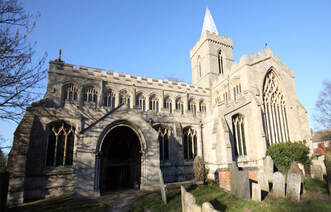
Church of St Peter and St Paul, Algarkirk, seeking funds for restoration project
We received an urgent update from St Peter and St Paul's Church, Algarkirk, which is in desperate need of repair. While not a Pugin church, it contains work by Crace and Hardman including the chancel and south transcept windows, and shows Pugin's influence throughout. The church told us the following and included the attached video:
The Algarkirk Major Project Group (AMPG) have been working for 5 years to raise funds to save the church before it is too late. We have now secured an HLF grant for over £1.7 million, which sounds huge, but barely covers the most essential work. BUT, before we can start work, we have to raise £300,000 in match funding. We hope to raise about £200k from specialist conservation charities, but the last £100k is going to have to come from private donations and fund-raising events. Can you help? The money will largely be used to reset the priceless stained glass and install a protective glass barrier against the weather; to clean and stabilize the painted decoration; to repair fragile masonry and cracked lead; to re-roof sections, and to install a heating system to protect the fabric from the shock of temperature changes. Having a church of this importance and beauty in our midst is a great blessing, but it is too great a burden for the 275 or so adults who live in this village. We will do all we can, but we need your help too.
We received an urgent update from St Peter and St Paul's Church, Algarkirk, which is in desperate need of repair. While not a Pugin church, it contains work by Crace and Hardman including the chancel and south transcept windows, and shows Pugin's influence throughout. The church told us the following and included the attached video:
The Algarkirk Major Project Group (AMPG) have been working for 5 years to raise funds to save the church before it is too late. We have now secured an HLF grant for over £1.7 million, which sounds huge, but barely covers the most essential work. BUT, before we can start work, we have to raise £300,000 in match funding. We hope to raise about £200k from specialist conservation charities, but the last £100k is going to have to come from private donations and fund-raising events. Can you help? The money will largely be used to reset the priceless stained glass and install a protective glass barrier against the weather; to clean and stabilize the painted decoration; to repair fragile masonry and cracked lead; to re-roof sections, and to install a heating system to protect the fabric from the shock of temperature changes. Having a church of this importance and beauty in our midst is a great blessing, but it is too great a burden for the 275 or so adults who live in this village. We will do all we can, but we need your help too.
|
Firstly please share this appeal with your friends and contacts, wherever they are. People left our village to settle in America, Australia, Canada and New Zealand. One of our medieval bronzes commemorates a merchant from the Low Countries. Your ancestors may have actually worked on the original reconstruction and still be buried in our churchyard. Who knows.
|
|
Secondly, please donate whatever you can by following the steps on this site. Believe me, every penny, euro, cent, or dollar will help. It is a mammoth task, but with your help, we can do this and preserve this "Mini Cathedral of the Fens" for future generations. Thank You!
Amid the sadness surrounding the fire at Notre Dame, a dire warning for the Houses of Parliament
As The Pugin Society extends our sympathy to the people of Paris and those who treasure Notre Dame Cathedral, we recall how, in the autumn of 1834, Pugin watched the medieval Houses of Parliament burn to the ground. Pugin took great pleasure in the destruction of the contemporary elements of the building as added by Wyatt and Soane, which detracted from the “true principles” present in the original medieval structure. He would later go on to write that it was in fact “a glorious sight to see…composition mullions and cement pinnacles and battlements flying and cracking while…turrets were smoking like so many manufacturing chimnies till the heat shivered them into a thousand pieces.” We are certain, however, that he would have had a much different reaction to the recent fire at Paris’ Notre Dame Cathedral. As the son of a French emigre, Pugin made frequent trips to the continent to study architecture and he certainly set foot inside the cathedral, whose medieval gothic style he held in utmost regard. Even the contemporary additions to this building such as Viollet-le-Duc’s spire (completed after Pugin’s death) were in keeping with the medieval style that Pugin held so dear.
As The Pugin Society extends our sympathy to the people of Paris and those who treasure Notre Dame Cathedral, we recall how, in the autumn of 1834, Pugin watched the medieval Houses of Parliament burn to the ground. Pugin took great pleasure in the destruction of the contemporary elements of the building as added by Wyatt and Soane, which detracted from the “true principles” present in the original medieval structure. He would later go on to write that it was in fact “a glorious sight to see…composition mullions and cement pinnacles and battlements flying and cracking while…turrets were smoking like so many manufacturing chimnies till the heat shivered them into a thousand pieces.” We are certain, however, that he would have had a much different reaction to the recent fire at Paris’ Notre Dame Cathedral. As the son of a French emigre, Pugin made frequent trips to the continent to study architecture and he certainly set foot inside the cathedral, whose medieval gothic style he held in utmost regard. Even the contemporary additions to this building such as Viollet-le-Duc’s spire (completed after Pugin’s death) were in keeping with the medieval style that Pugin held so dear.
From L-R: The Palace of Westminster on Fire, 1834, by an unknown artist; the conflagration at Notre Dame,
15th April 2019; the Houses of Parliament today.
While we share in the sadness of the overwhelming destruction caused by the fire, we are also certain that the French people, the Catholic community, and lovers of art and architecture worldwide will ensure the cathedral is rebuilt. But we also cannot help but return to the similarity between Notre Dame and Britain’s structures of national importance, namely the new Houses of Parliament. As the flames destroyed its medieval precursor, Pugin saw an opportunity to create an even more impressive structure, and he and Charles Barry certainly delivered on that account. It seems, however, that almost two hundred years later we haven’t learned from the events that led to the initial destruction; or, more likely, that we willfully ignore these lessons from the past and set ourselves up for future devastation.
An eagle-eyed follower brought the article Fears for UK Parliament after Notre Dame Blaze to our attention, although it is a message of which we have been acutely aware for some time. Here the author states that “The Palace of Westminster could face a fire as devastating as the one that has ravaged Notre Dame unless major improvements are made to the crumbling building in central London.” An engineering marvel at its date of construction, the Houses of Parliament are now in desperate need of updating. Last year the members of parliament voted to leave the building so that renovations could occur, but this work is not set to start until the mid 2020s. Let us learn from the tragedy in Paris and ensure that national (and indeed, international) treasures such as the Houses of Parliament are valued and protected. As MP Chris Bryant points out, “Parts of the Palace are as old as Notre Dame and we must make sure that every fire precaution is taken as the major work goes ahead. God knows we’ve had enough warnings.”
An eagle-eyed follower brought the article Fears for UK Parliament after Notre Dame Blaze to our attention, although it is a message of which we have been acutely aware for some time. Here the author states that “The Palace of Westminster could face a fire as devastating as the one that has ravaged Notre Dame unless major improvements are made to the crumbling building in central London.” An engineering marvel at its date of construction, the Houses of Parliament are now in desperate need of updating. Last year the members of parliament voted to leave the building so that renovations could occur, but this work is not set to start until the mid 2020s. Let us learn from the tragedy in Paris and ensure that national (and indeed, international) treasures such as the Houses of Parliament are valued and protected. As MP Chris Bryant points out, “Parts of the Palace are as old as Notre Dame and we must make sure that every fire precaution is taken as the major work goes ahead. God knows we’ve had enough warnings.”

Paul Atterbury to speak at Pugin Society AGM in December
This year is the 25th anniversary of Pugin: A Gothic Passion the Victoria and Albert museum’s magisterial exhibition which firmly established AWN Pugin’s reputation in the national consciousness.
To mark the occasion, Paul Atterbury, of BBC 1’s Antiques Roadshow, who curated the exhibition with the late Clive Wainwright, Senior Research Fellow in 19th Century Studies at the V&A, will speak to the AGM of the Pugin Society in December.
Three years in preparation the exhibition ran from June to September 1994, attracting more than 74,000 visitors and wide press coverage. It was followed in the winter of 1995-1996 by AWN Pugin: Master of Gothic Revival an exhibition at the Bard Center, New York, also curated by Paul Atterbury.
Catriona Blaker, co-founder of the Pugin Society, said “We are delighted that Paul Atterbury has agreed to talk about the major exhibition which made so many people more aware of Pugin. Held before the Landmark Trust’s restoration of The Grange, Pugin’s house in Ramsgate, and before the formation of the Pugin Society the exhibition was a real trailblazer which led to an unimaginable advance in understanding of all Pugin stood for.”
This year is the 25th anniversary of Pugin: A Gothic Passion the Victoria and Albert museum’s magisterial exhibition which firmly established AWN Pugin’s reputation in the national consciousness.
To mark the occasion, Paul Atterbury, of BBC 1’s Antiques Roadshow, who curated the exhibition with the late Clive Wainwright, Senior Research Fellow in 19th Century Studies at the V&A, will speak to the AGM of the Pugin Society in December.
Three years in preparation the exhibition ran from June to September 1994, attracting more than 74,000 visitors and wide press coverage. It was followed in the winter of 1995-1996 by AWN Pugin: Master of Gothic Revival an exhibition at the Bard Center, New York, also curated by Paul Atterbury.
Catriona Blaker, co-founder of the Pugin Society, said “We are delighted that Paul Atterbury has agreed to talk about the major exhibition which made so many people more aware of Pugin. Held before the Landmark Trust’s restoration of The Grange, Pugin’s house in Ramsgate, and before the formation of the Pugin Society the exhibition was a real trailblazer which led to an unimaginable advance in understanding of all Pugin stood for.”
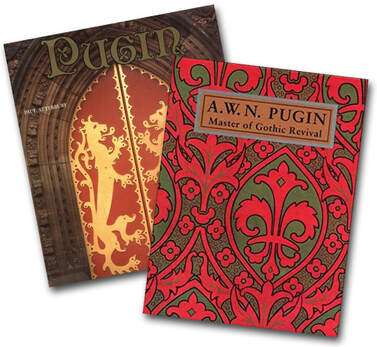
Paul Atterbury, a freelance writer and lecturer specialising in 19th and 20th century art and design, formerly adviser to Royal Doulton and editor of Connoisseur magazine, has been part of the Antiques Roadshow team of experts for 29 years.
His books include: English Pottery and Porcelain,The Dictionary of Minton (With Maureen Batkin,) Art Deco Patterns, Twentieth Century Ceramics, Discovering Britain’s Lost Railways and the First World War in 100 Family Treasures.
Looking back on his time preparing the exhibition he said he was astounded by Pugin’s productivity, and influence. “As I came to understand this largely forgotten man, I realised he was one of the key designers on the 19th century. Much of Britain reflects his influence.”
The guide, Pugin: A Gothic Passion published by the V&A, in conjunction with Yale University Press, to coincide with the 1994 exhibition, is still available from Abe books. Edited by Paul Atterbury and Clive Wainwright and highly illustrated it includes chapters by Margaret Belcher, David Meara, Roderick O’Donnell, Stanley Shepherd and Alexandra Wedgwood.
The AGM of the Pugin Society will be held on Saturday December 7th at the Art Workers’ Guild, Queen Square, London WC1N 3AT, starting at 12pm.
His books include: English Pottery and Porcelain,The Dictionary of Minton (With Maureen Batkin,) Art Deco Patterns, Twentieth Century Ceramics, Discovering Britain’s Lost Railways and the First World War in 100 Family Treasures.
Looking back on his time preparing the exhibition he said he was astounded by Pugin’s productivity, and influence. “As I came to understand this largely forgotten man, I realised he was one of the key designers on the 19th century. Much of Britain reflects his influence.”
The guide, Pugin: A Gothic Passion published by the V&A, in conjunction with Yale University Press, to coincide with the 1994 exhibition, is still available from Abe books. Edited by Paul Atterbury and Clive Wainwright and highly illustrated it includes chapters by Margaret Belcher, David Meara, Roderick O’Donnell, Stanley Shepherd and Alexandra Wedgwood.
The AGM of the Pugin Society will be held on Saturday December 7th at the Art Workers’ Guild, Queen Square, London WC1N 3AT, starting at 12pm.
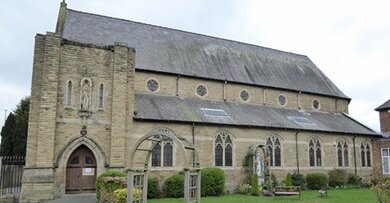
St Edwards Rusholme threated with closure
Designed by E. W. Pugin in 1862, the church is facing closure. As the church is of significant historical, religious, cultural and social value to the community, a petition has been established and while it doesn't originate with the Pugin Society, we support the efforts to keep this building open. Please consider showing your support by signing HERE. Alternately, you may also contact the Bishop of Salford, the Right Reverend John Arnold at [email protected] and copy the email to the Vicar General, Rev Mgr John Daly at [email protected]. If you prefer to write a letter, the postal address is Wardley Hall, Worsley, Manchester, M28 2ND.
Designed by E. W. Pugin in 1862, the church is facing closure. As the church is of significant historical, religious, cultural and social value to the community, a petition has been established and while it doesn't originate with the Pugin Society, we support the efforts to keep this building open. Please consider showing your support by signing HERE. Alternately, you may also contact the Bishop of Salford, the Right Reverend John Arnold at [email protected] and copy the email to the Vicar General, Rev Mgr John Daly at [email protected]. If you prefer to write a letter, the postal address is Wardley Hall, Worsley, Manchester, M28 2ND.
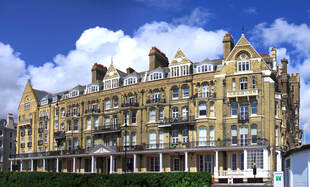
Edward Pugin's Granville House under threat from developers
Edward Pugin supporters and enthusiasts will be interested to hear that the Granville Bars, last remaining public section of Pugin's Granville House, formerly the Granville Hotel, in Ramsgate was recently acquired at auction for £310,000. They will be alarmed to learn that the purchaser hopes to convert this part of the building, including its extensive basement, into flats. Planning application has not yet been sought, but the plans, which have been displayed to residents, have been seen by local members of the Pugin Society committee. They are not appropriate for the character and historic use of such a significant building, listed Grade Two and of great architectural and historical importance. Of particular concern is the intention to divide Edward Pugin's great dining hall, with its extant decorative ceiling and great Gothic fireplace, into three apartments. The plans run counter to the whole spirit and nature of the building, which is a landmark in the town. Watch this space for further update.
Edward Pugin supporters and enthusiasts will be interested to hear that the Granville Bars, last remaining public section of Pugin's Granville House, formerly the Granville Hotel, in Ramsgate was recently acquired at auction for £310,000. They will be alarmed to learn that the purchaser hopes to convert this part of the building, including its extensive basement, into flats. Planning application has not yet been sought, but the plans, which have been displayed to residents, have been seen by local members of the Pugin Society committee. They are not appropriate for the character and historic use of such a significant building, listed Grade Two and of great architectural and historical importance. Of particular concern is the intention to divide Edward Pugin's great dining hall, with its extant decorative ceiling and great Gothic fireplace, into three apartments. The plans run counter to the whole spirit and nature of the building, which is a landmark in the town. Watch this space for further update.
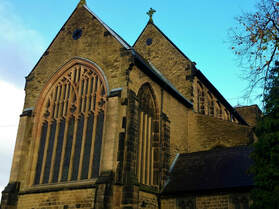
St Alban's Restoration Project Update and Heritage Website
The first phase of the restoration programme at St Alban’s, Macclesfield, is reaching completion. Designed by Pugin in 1838 and built between 1839-1841, recent inspection reports of the Grade II* listed building noted several concerns, including rotted roof timbers, inadequate drainage, and damp. With repair costs estimated at £300,000, the parish received support from the Heritage Lottery Fund, the National Churches Trust, and Shrewsbury Diocese alongside fundraising efforts within the parish community. We are pleased to share a link to the heritage and restoration website, located HERE, which features details of the project and a Virtual Tour.
The first phase of the restoration programme at St Alban’s, Macclesfield, is reaching completion. Designed by Pugin in 1838 and built between 1839-1841, recent inspection reports of the Grade II* listed building noted several concerns, including rotted roof timbers, inadequate drainage, and damp. With repair costs estimated at £300,000, the parish received support from the Heritage Lottery Fund, the National Churches Trust, and Shrewsbury Diocese alongside fundraising efforts within the parish community. We are pleased to share a link to the heritage and restoration website, located HERE, which features details of the project and a Virtual Tour.

Parliamentary vacancy in Heritage may be of interest to Pugin aficionados
The Houses of Parliament has recently advertised an opening for the Head of Heritage Collections. The advertisement states that applicants "will be an expert in the field of Victorian art and design and collection management who use their specialist knowledge to represent and promote Parliament’s heritage collections" which include "furniture, decorative arts, library holdings, wallpapers and architectural fabric" - all areas for which Pugin was highly involved. Although a specific knowledge of Pugin is not required for the job, it is our opinion that the ideal candidate would be aware of and sympathetic to Pugin's importance at the Palace, and we urge any of our readers who are qualified in these areas to apply and ensure that Pugin's contributions do not go unappreciated. For more information about the role, view the job listing HERE.
The Houses of Parliament has recently advertised an opening for the Head of Heritage Collections. The advertisement states that applicants "will be an expert in the field of Victorian art and design and collection management who use their specialist knowledge to represent and promote Parliament’s heritage collections" which include "furniture, decorative arts, library holdings, wallpapers and architectural fabric" - all areas for which Pugin was highly involved. Although a specific knowledge of Pugin is not required for the job, it is our opinion that the ideal candidate would be aware of and sympathetic to Pugin's importance at the Palace, and we urge any of our readers who are qualified in these areas to apply and ensure that Pugin's contributions do not go unappreciated. For more information about the role, view the job listing HERE.

BBC rebroadcasts Pugin: God's Own Architect
BBC 4 has decided to once again air Pugin: God's Own Architect, a 2012 documentary that surveys Pugin's work and features various Pugin experts and society members. The BBC offers the following summary:
"Augustus Northmore Welby Pugin is far from being a household name, yet he designed the iconic clock tower of Big Ben as well as much of the Palace of Westminster. The 19th-century Gothic revival that Pugin inspired, with its medieval influences and soaring church spires, established an image of Britain which still defines the nation. Richard Taylor charts Pugin's extraordinary life story and discovers how his work continues to influence Britain today."
The program is available online for a limited amount of time and is restricted to UK viewers only, but one of our facebook followers mentioned that the programme is always available to a worldwide audience on YouTube. The programme is divided into four 15-minute segments which can be viewed at the following links:
Part 1 - https://youtu.be/WevOim4F3dk
Part 2 - https://youtu.be/sWchXRp4E7Q
Part 3 - https://youtu.be/m60TGUjrGmE
Part 4 - https://youtu.be/K5F1zYJTq9c
BBC 4 has decided to once again air Pugin: God's Own Architect, a 2012 documentary that surveys Pugin's work and features various Pugin experts and society members. The BBC offers the following summary:
"Augustus Northmore Welby Pugin is far from being a household name, yet he designed the iconic clock tower of Big Ben as well as much of the Palace of Westminster. The 19th-century Gothic revival that Pugin inspired, with its medieval influences and soaring church spires, established an image of Britain which still defines the nation. Richard Taylor charts Pugin's extraordinary life story and discovers how his work continues to influence Britain today."
The program is available online for a limited amount of time and is restricted to UK viewers only, but one of our facebook followers mentioned that the programme is always available to a worldwide audience on YouTube. The programme is divided into four 15-minute segments which can be viewed at the following links:
Part 1 - https://youtu.be/WevOim4F3dk
Part 2 - https://youtu.be/sWchXRp4E7Q
Part 3 - https://youtu.be/m60TGUjrGmE
Part 4 - https://youtu.be/K5F1zYJTq9c

Channel 4's Big Ben: Countdown to New Year examines restoration progress
The Elizabeth Tower, aka Big Ben, is currently clad in scaffolding and largely hidden, so what exactly is going on behind this metal skeleton? Dr. Anna Keay, Director of the Landmark Trust, revisits this topic in a follow up to a November 2017 episode on this same topic.
The second episode of a three-part documentary series goes behind-the-scenes as Dr Keay visits specialists to examine the restoration processes taking place across the country. Alas,if you missed the original air date the episode is no longer available online. We will let readers know should it appear on an alterative source such as YouTube. In the meantime, the Parliamentary Media Office has released a teaser/summary of the episode which can be found HERE.
The Elizabeth Tower, aka Big Ben, is currently clad in scaffolding and largely hidden, so what exactly is going on behind this metal skeleton? Dr. Anna Keay, Director of the Landmark Trust, revisits this topic in a follow up to a November 2017 episode on this same topic.
The second episode of a three-part documentary series goes behind-the-scenes as Dr Keay visits specialists to examine the restoration processes taking place across the country. Alas,if you missed the original air date the episode is no longer available online. We will let readers know should it appear on an alterative source such as YouTube. In the meantime, the Parliamentary Media Office has released a teaser/summary of the episode which can be found HERE.
2018
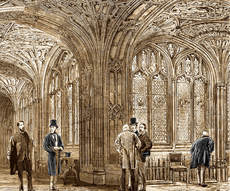
St Stephens Cloisters the topic of this year's AGM talk
Society members are invited to attend this year's AGM, Saturday December 15th at the Art Workers’ Guild, Queen Square, London WC1N 3AT. The speaker at this year’s AGM will be Dr Elizabeth Hallam Smith FSA, former director of Information Services and Librarian at the House of Lords, who will talk on The ‘Gothic Slum’? The chequered history of St Stephen’s cloisters, Palace of Westminster, 1510-2017.
A lavish building - perhaps part-funded by King Henry VIII - St Stephen’s cloisters at Westminster are a strong stylistic match with the nearby Henry VII chapel at Westminster Abbey. Yet they met their original religious and ceremonial purposes for little more than 20 years, and this illustrated talk will trace the subsequent fate of this little-known survival of the old Palace of Westminster.
The proximity of this fragile fragment to the House of Commons and to central government has always shaped its destiny. Since 1548 when St Stephen's College was dissolved and its chapel allocated to the Commons, its cloisters have suffered from neglect, flooding and subsidence, and from two major episodes of fire and bomb damage. They have over the centuries also been used in many unsuitable ways - from a store for fuel to a party venue, from a kitchen to cloakrooms and offices for MPs. Yet they have also been a source of great inspiration to antiquaries and to their notable restorers, from James Wyatt to Giles Gilbert Scott - via Charles Barry and Pugin himself. Despite all the vicissitudes and indignities to which they have been subjected, much of the original design of the cloisters and even some original fabric survives; and their upcoming restoration should allow the Houses of Parliament to draw on past experience to shape their future.
Dr Hallam Smith is now a Leverhulme Trust Emeritus Research Fellow, based at the Houses of Parliament and the University of York. She is researching the history of St Stephen's cloisters and St Mary Undercroft, 1348-2020, and has published widely on a variety of topics including the Chapter House at Westminster and the history of Domesday Book.
This year’s AGM will include a presentation to Father Marcus Holden, until recently rector at St Augustine’s, Ramsgate, where he led an eight year £2million restoration of the church Pugin once described as “my own child”.
The AGM will start at 12.00, followed by the talk and a buffet lunch with wine. Tickets for the lunch, which must be bought in advance, are £32.
Send cheque, made payable to the Pugin Society, to Professor Julia Twigg, 9 Nunnery Road, Canterbury, Kent CT1 3LS, with either SAE or email for ticket.
Society members are invited to attend this year's AGM, Saturday December 15th at the Art Workers’ Guild, Queen Square, London WC1N 3AT. The speaker at this year’s AGM will be Dr Elizabeth Hallam Smith FSA, former director of Information Services and Librarian at the House of Lords, who will talk on The ‘Gothic Slum’? The chequered history of St Stephen’s cloisters, Palace of Westminster, 1510-2017.
A lavish building - perhaps part-funded by King Henry VIII - St Stephen’s cloisters at Westminster are a strong stylistic match with the nearby Henry VII chapel at Westminster Abbey. Yet they met their original religious and ceremonial purposes for little more than 20 years, and this illustrated talk will trace the subsequent fate of this little-known survival of the old Palace of Westminster.
The proximity of this fragile fragment to the House of Commons and to central government has always shaped its destiny. Since 1548 when St Stephen's College was dissolved and its chapel allocated to the Commons, its cloisters have suffered from neglect, flooding and subsidence, and from two major episodes of fire and bomb damage. They have over the centuries also been used in many unsuitable ways - from a store for fuel to a party venue, from a kitchen to cloakrooms and offices for MPs. Yet they have also been a source of great inspiration to antiquaries and to their notable restorers, from James Wyatt to Giles Gilbert Scott - via Charles Barry and Pugin himself. Despite all the vicissitudes and indignities to which they have been subjected, much of the original design of the cloisters and even some original fabric survives; and their upcoming restoration should allow the Houses of Parliament to draw on past experience to shape their future.
Dr Hallam Smith is now a Leverhulme Trust Emeritus Research Fellow, based at the Houses of Parliament and the University of York. She is researching the history of St Stephen's cloisters and St Mary Undercroft, 1348-2020, and has published widely on a variety of topics including the Chapter House at Westminster and the history of Domesday Book.
This year’s AGM will include a presentation to Father Marcus Holden, until recently rector at St Augustine’s, Ramsgate, where he led an eight year £2million restoration of the church Pugin once described as “my own child”.
The AGM will start at 12.00, followed by the talk and a buffet lunch with wine. Tickets for the lunch, which must be bought in advance, are £32.
Send cheque, made payable to the Pugin Society, to Professor Julia Twigg, 9 Nunnery Road, Canterbury, Kent CT1 3LS, with either SAE or email for ticket.
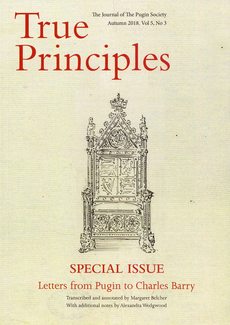
“I live in hope but this job pays worse than the worst job I ever had” Previously unpublished letters highlight the financial difficulties Pugin endured working on the Palace of Westminster. by Joanna Lyall • November 8, 2018
Previously unpublished letters written by Pugin in the last eight years of his life shed new light on his relationship with Sir Charles Barry, architect of the Palace of Westminster, and the financial stresses of their collaboration.
Covering the period 1844 to Pugin’s death in 1852, the letters are published in True Principles, the journal of the Pugin Society. They were produced by the Barry family in 2015 and bought by the Parliamentary Archives.
In her introduction, Margaret Belcher, who edited five volumes of Pugin’s letters before her death in November 2016, writes: “The collaboration between Pugin and Barry was one of the most important architectural partnerships of the nineteenth century yet strikingly little is known about the daily dealings of the two men. “Few though these letters may be among the hundreds that must have passed between them, they set forth Pugin’s attitude to Barry with greater clarity than has been available before.”
While Pugin shows consistent respect for Barry, describing himself as “a most faithful Lieuten it is clear that agreements on expenses are not adhered to. “Although Pugin asks and argues for reimbursement time and again, it is delayed, insufficient, grudging – if forthcoming at all,” Belcher writes. “It is plain Barry took advantage of Pugin’s generosity.”
In a letter, thought to been written in May 1846, discussing the design for the throne in the House of Lords, Pugin mentions the difficulties of having to advance expenses to craftsmen, and says: “I live in hope but this job pays worse than the worst job I ever had.”
“You know I am not an unreasonable man & I am most anxious to carry out all your ideas but I must consider my own interest a little & when I come to reckon up the time expended & the returns they are very unsatisfactory.”
In another letter Pugin says: “The work I do for you is very difficult & harassing & does not provide even a decent remuneration” Barry would be doing him a favour to let him give up, Pugin suggests.
In a letter from his home in Ramsgate, thought to have been written in January 1848, Pugin says: “I cannot find money for the government, if they do not place proper funds at your disposal it is not my fault. I am out of all heart. I do nothing but pay and work & it is enough to dishearten anybody.”
In the last letter in the special edition of True Principles, edited by David Frazer Lewis, with notes by Alexandra Wedgwood, Pugin taunts Barry for holding out hopes of payment which does not materialise and jokes that Barry he may be haunted by visions of unpaid expenses. “But I am afraid your heart is steeled to Supernatural influence.”
A list of expenses, thought to have been sent to Barry in January 1852, nine months before Pugin’s death, covers 67 items including chandeliers, ceiling lights, railings, bell pulls, brackets and ironwork and demonstrates the immense amount of work he continued to do on the Palace of Westminster up to his final breakdown.
“It is plain that Barry took advantage of Pugin’s generosity. Pugin could have refused to make more drawings, yet it was not in his nature to either give up or drive a hard bargain.” Margaret Belcher concluded.
“Barry was the steely ambitious one: he continues to call for designs, apparently knowing that Pugin will not be paid for them; he does not emerge from these letters as the more attractive character. His justification for such unworthy treatment lay in his determination to secure for his country the best possible building to be obtained from the resources at his command.”
Previously unpublished letters written by Pugin in the last eight years of his life shed new light on his relationship with Sir Charles Barry, architect of the Palace of Westminster, and the financial stresses of their collaboration.
Covering the period 1844 to Pugin’s death in 1852, the letters are published in True Principles, the journal of the Pugin Society. They were produced by the Barry family in 2015 and bought by the Parliamentary Archives.
In her introduction, Margaret Belcher, who edited five volumes of Pugin’s letters before her death in November 2016, writes: “The collaboration between Pugin and Barry was one of the most important architectural partnerships of the nineteenth century yet strikingly little is known about the daily dealings of the two men. “Few though these letters may be among the hundreds that must have passed between them, they set forth Pugin’s attitude to Barry with greater clarity than has been available before.”
While Pugin shows consistent respect for Barry, describing himself as “a most faithful Lieuten it is clear that agreements on expenses are not adhered to. “Although Pugin asks and argues for reimbursement time and again, it is delayed, insufficient, grudging – if forthcoming at all,” Belcher writes. “It is plain Barry took advantage of Pugin’s generosity.”
In a letter, thought to been written in May 1846, discussing the design for the throne in the House of Lords, Pugin mentions the difficulties of having to advance expenses to craftsmen, and says: “I live in hope but this job pays worse than the worst job I ever had.”
“You know I am not an unreasonable man & I am most anxious to carry out all your ideas but I must consider my own interest a little & when I come to reckon up the time expended & the returns they are very unsatisfactory.”
In another letter Pugin says: “The work I do for you is very difficult & harassing & does not provide even a decent remuneration” Barry would be doing him a favour to let him give up, Pugin suggests.
In a letter from his home in Ramsgate, thought to have been written in January 1848, Pugin says: “I cannot find money for the government, if they do not place proper funds at your disposal it is not my fault. I am out of all heart. I do nothing but pay and work & it is enough to dishearten anybody.”
In the last letter in the special edition of True Principles, edited by David Frazer Lewis, with notes by Alexandra Wedgwood, Pugin taunts Barry for holding out hopes of payment which does not materialise and jokes that Barry he may be haunted by visions of unpaid expenses. “But I am afraid your heart is steeled to Supernatural influence.”
A list of expenses, thought to have been sent to Barry in January 1852, nine months before Pugin’s death, covers 67 items including chandeliers, ceiling lights, railings, bell pulls, brackets and ironwork and demonstrates the immense amount of work he continued to do on the Palace of Westminster up to his final breakdown.
“It is plain that Barry took advantage of Pugin’s generosity. Pugin could have refused to make more drawings, yet it was not in his nature to either give up or drive a hard bargain.” Margaret Belcher concluded.
“Barry was the steely ambitious one: he continues to call for designs, apparently knowing that Pugin will not be paid for them; he does not emerge from these letters as the more attractive character. His justification for such unworthy treatment lay in his determination to secure for his country the best possible building to be obtained from the resources at his command.”
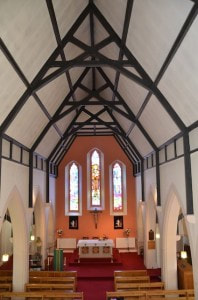
Gerard Hyland to speak at EW Pugin's restored St Stephen's Church, Blairgowrie
St Stephen’s Church in Blairgowrie has recently undergone a significant restoration programme supported by funding from the Heritage Lottery Fund. This building, somewhat hidden up a side street in the town, is of huge historical significance, having been designed by E W Pugin, a member of the Pugin architectural dynasty, best known for their plans for the Houses of Parliament in London.
Over the 23 years of his career, EW Pugin's designs for Catholic places of worship constituted Cathedrals, Parish Churches, Chapels and Schoolroom buildings, both in the UK and overseas.
He invariably succeeded in producing, even in the most deprived areas, dignified places of worship that became the focal point of the Catholic community, and which were very often the only place of beauty in the locality to which people of all classes had access, and in which they could take justifiable pride, and with which - as opposed to simply in which - they could worship in a correspondingly dignified way.
St Stephen’s is the first of only four parish churches in Scotland designed by him.
Dr Gerard Hyland will deliver a lecture on Friday 5th October at 3pm in St Stephen’s Church on 'The work of the Pugins in Scotland, and Blairgowrie in particular.' All members of the public are invited to attend this free event, which will be of particular interest to students and professionals of architecture, heritage and the built environment, as well as members of civic and other societies. A short video of the restoration works will also be shown. Over light refreshments, there will an opportunity to view a display of renowned Celtic Artwork by parishioner Larry Scrimgeour.
Co-ordinator Marion Duffy commented ‘previously, parishioners were largely unaware of the historical significance of their Gothic inspired church building. The restoration programme has stimulated interest in both its design and its place in architectural history. We welcome all those interested to join us for this event.’
St Stephen’s Church in Blairgowrie has recently undergone a significant restoration programme supported by funding from the Heritage Lottery Fund. This building, somewhat hidden up a side street in the town, is of huge historical significance, having been designed by E W Pugin, a member of the Pugin architectural dynasty, best known for their plans for the Houses of Parliament in London.
Over the 23 years of his career, EW Pugin's designs for Catholic places of worship constituted Cathedrals, Parish Churches, Chapels and Schoolroom buildings, both in the UK and overseas.
He invariably succeeded in producing, even in the most deprived areas, dignified places of worship that became the focal point of the Catholic community, and which were very often the only place of beauty in the locality to which people of all classes had access, and in which they could take justifiable pride, and with which - as opposed to simply in which - they could worship in a correspondingly dignified way.
St Stephen’s is the first of only four parish churches in Scotland designed by him.
Dr Gerard Hyland will deliver a lecture on Friday 5th October at 3pm in St Stephen’s Church on 'The work of the Pugins in Scotland, and Blairgowrie in particular.' All members of the public are invited to attend this free event, which will be of particular interest to students and professionals of architecture, heritage and the built environment, as well as members of civic and other societies. A short video of the restoration works will also be shown. Over light refreshments, there will an opportunity to view a display of renowned Celtic Artwork by parishioner Larry Scrimgeour.
Co-ordinator Marion Duffy commented ‘previously, parishioners were largely unaware of the historical significance of their Gothic inspired church building. The restoration programme has stimulated interest in both its design and its place in architectural history. We welcome all those interested to join us for this event.’
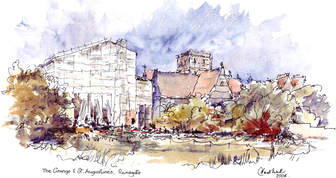
Landmark Trust offer comprehensive reports on the History and Restoration of the Grange
Although these publications are not new, originally being published in 2006, we thought we would draw your attention to the depth and breadth of information these sources provide. Written by Caroline Stanford, each text is approximately 70 pages including a variety of colour photographs and illustrations, such as the watercolour of the restoration by David Insall, shown here. Stanford examines the history of Pugin's home and the extensive efforts that went into restoring it to its original condition. The Landmark Trust notes that they do not offer printed versions of this information, but PDFs are freely available from their website.
History Album Volume I: The Pugin Family and the Grange is available HERE.
History Album Volume II: The Significance and Restoration of The Grange is available HERE.
Although these publications are not new, originally being published in 2006, we thought we would draw your attention to the depth and breadth of information these sources provide. Written by Caroline Stanford, each text is approximately 70 pages including a variety of colour photographs and illustrations, such as the watercolour of the restoration by David Insall, shown here. Stanford examines the history of Pugin's home and the extensive efforts that went into restoring it to its original condition. The Landmark Trust notes that they do not offer printed versions of this information, but PDFs are freely available from their website.
History Album Volume I: The Pugin Family and the Grange is available HERE.
History Album Volume II: The Significance and Restoration of The Grange is available HERE.
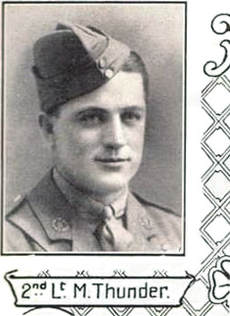
Pugin's grandson honored at Armistice Day
Michael Hubert Thunder (1881-1916), a grandson of Augustus Pugin, is a member of the family that we might well be thinking of as Armistice Day approaches. The sixth child of Margaret Pugin, Michael was educated at St. Augustine’s College, Ramsgate. He was wounded in the Boer War, and died as an RFC pilot in World War I after crashing after take-off. Michael is buried in the graveyard at St Augustine’s in Ramsgate. While his great-nephew and Society member Jim Thunder has done much to promote Pugin and his family in the USA, his retrospective study of his uncle's life resonates both at home and abroad. Read the condensed article HERE, and for a more a more comprehensive survey, click HERE.
Michael Hubert Thunder (1881-1916), a grandson of Augustus Pugin, is a member of the family that we might well be thinking of as Armistice Day approaches. The sixth child of Margaret Pugin, Michael was educated at St. Augustine’s College, Ramsgate. He was wounded in the Boer War, and died as an RFC pilot in World War I after crashing after take-off. Michael is buried in the graveyard at St Augustine’s in Ramsgate. While his great-nephew and Society member Jim Thunder has done much to promote Pugin and his family in the USA, his retrospective study of his uncle's life resonates both at home and abroad. Read the condensed article HERE, and for a more a more comprehensive survey, click HERE.
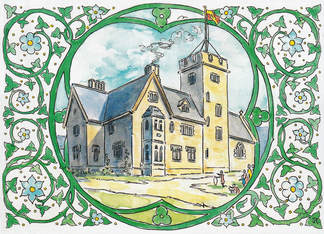
Illustrator of children’s book inspired by Pugin’s Gothic vision by Joanna Lyall
James Robinson, illustrator of the new children’s book, Mr Pugin was inspired by the architect’s ideas on life and buildings and wanted to bring these to a young readership. James, now 21, grew up at St Edmund’s College, Ware, Hertfordshire, where Pugin designed the chapel, and his father Alan Robinson is head of boys’ boarding.
“I have always liked Pugin’s view of life and his vision of a Gothic England inspired me,” said James. “I was also influenced by the illustrators, James Mayhew, Arthur Rackham and Edward Ardizzone and wanted to go for a fairly traditional style.”
“Of course it was impossible to incorporate all of Pugin’s huge output but I hope the fact every page is fully illustrated makes the book attractive.” Illustrations in the book, which follows Pugin’s life story, include St Augustine’s and The Grange, Pugin’s family home, as well as St Marie’s Grange, St Giles Cheadle, and the House of Lords.
James is one of six children all home schooled by their mother, Suzanne Robinson, a former history teacher, who wrote the text for the book. When he was 18 James illustrated a book on home schooling, available HERE from Eyrie Press. He was commissioned for the Pugin book, when Father Marcus Holden, former rector of St Augustine’s, Ramsgate, visited St Edmund’s for a conference and saw James’s Christmas cards.
“I was very excited by the project and just dived in and did lots of research and worked on it for three months,” he said. James has been working on commissions for illustration since he was 16 and now hopes to take himself to art school in Florence on the proceeds.
To view James' works, click HERE. Mr Pugin is available from the Pugin Centre, St Augustine’s Ramsgate, price £5.50, or £9.50 p&p. To purchase, contact [email protected], or ring 0730 531 7642
James Robinson, illustrator of the new children’s book, Mr Pugin was inspired by the architect’s ideas on life and buildings and wanted to bring these to a young readership. James, now 21, grew up at St Edmund’s College, Ware, Hertfordshire, where Pugin designed the chapel, and his father Alan Robinson is head of boys’ boarding.
“I have always liked Pugin’s view of life and his vision of a Gothic England inspired me,” said James. “I was also influenced by the illustrators, James Mayhew, Arthur Rackham and Edward Ardizzone and wanted to go for a fairly traditional style.”
“Of course it was impossible to incorporate all of Pugin’s huge output but I hope the fact every page is fully illustrated makes the book attractive.” Illustrations in the book, which follows Pugin’s life story, include St Augustine’s and The Grange, Pugin’s family home, as well as St Marie’s Grange, St Giles Cheadle, and the House of Lords.
James is one of six children all home schooled by their mother, Suzanne Robinson, a former history teacher, who wrote the text for the book. When he was 18 James illustrated a book on home schooling, available HERE from Eyrie Press. He was commissioned for the Pugin book, when Father Marcus Holden, former rector of St Augustine’s, Ramsgate, visited St Edmund’s for a conference and saw James’s Christmas cards.
“I was very excited by the project and just dived in and did lots of research and worked on it for three months,” he said. James has been working on commissions for illustration since he was 16 and now hopes to take himself to art school in Florence on the proceeds.
To view James' works, click HERE. Mr Pugin is available from the Pugin Centre, St Augustine’s Ramsgate, price £5.50, or £9.50 p&p. To purchase, contact [email protected], or ring 0730 531 7642
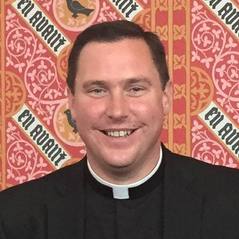
Pugin’s personal church faces wonderful future says departing rector of St Augustine’s, Ramsgate. September 14, 2018
“A whole host of people told me it was impossible to save but we just kept going,” said Father Marcus Holden in a packed farewell talk in the visitor centre of St Augustine’s, Ramsgate. Looking back on the eight year £2million restoration of the church Pugin once described as “my own child” Father Marcus, who will be moving next month to become parish priest of St Bede’s, Clapham, London, said: “I want to offer this as a story of providence. I have been caught up as a player in a great project,” he said.
“It has been challenging but we have received immense blessings.”
In 2010, with an inkling that he might be moved from Tunbridge Wells, where he was assistant priest, to St Augustine’s he made a secret visit to Ramsgate with his mother and they listened to a talk about Pugin in The Grange. “He sounds like you,” was his mother’s verdict.
Parking on the seafront he went into St Augustine’s and immediately sensed its atmosphere. “The darkness and dustiness made it even more enticing and when I got to the chantry chapel I prayed that if it was God’s will I would go to Ramsgate,” he said. Soon after he learned that St Augustine’s had been set for closure.
Arriving as parish priest he drew up a plan for renewal, initially consisting of “create Friends, produce pamphlet”, but the project quickly gathered momentum and supporters. “It has been very much a group enterprise,” he said.
The restoration drew national attention with visits from the Duke of Kent, Sir Andrew Lloyd Webber, broadcaster Alastair Stewart and Clive Aslet, former editor of Country Life.
Father Marcus paid tribute to the architect, Paul Sharrock, John Coverdale, former centre manager, the Pugin Society and a large number of volunteers. “The right people arrived at the right time,” he said.
Particular highlights had been the locating of a relic of St Augustine and the church being declared the saint’s official shrine in 2012, winning a £1.2million grant from the Heritage Lottery Fund and the restoration of the church’s rood screen.
“Eight years is a kind of fullness and I am really confident the next chapter will be wonderful. The adventure continues. En avant!” he said.
In an earlier message to parishioners Father Marcus said “I have been parish priest in Ramsgate and Minster for eight years and it has been the greatest joy of my life. This was my first appointment as parish priest and it will always be closest to my heart.”
Father Christopher Basden has been appointed new parish priest in Ramsgate and will start work after Christmas.
“A whole host of people told me it was impossible to save but we just kept going,” said Father Marcus Holden in a packed farewell talk in the visitor centre of St Augustine’s, Ramsgate. Looking back on the eight year £2million restoration of the church Pugin once described as “my own child” Father Marcus, who will be moving next month to become parish priest of St Bede’s, Clapham, London, said: “I want to offer this as a story of providence. I have been caught up as a player in a great project,” he said.
“It has been challenging but we have received immense blessings.”
In 2010, with an inkling that he might be moved from Tunbridge Wells, where he was assistant priest, to St Augustine’s he made a secret visit to Ramsgate with his mother and they listened to a talk about Pugin in The Grange. “He sounds like you,” was his mother’s verdict.
Parking on the seafront he went into St Augustine’s and immediately sensed its atmosphere. “The darkness and dustiness made it even more enticing and when I got to the chantry chapel I prayed that if it was God’s will I would go to Ramsgate,” he said. Soon after he learned that St Augustine’s had been set for closure.
Arriving as parish priest he drew up a plan for renewal, initially consisting of “create Friends, produce pamphlet”, but the project quickly gathered momentum and supporters. “It has been very much a group enterprise,” he said.
The restoration drew national attention with visits from the Duke of Kent, Sir Andrew Lloyd Webber, broadcaster Alastair Stewart and Clive Aslet, former editor of Country Life.
Father Marcus paid tribute to the architect, Paul Sharrock, John Coverdale, former centre manager, the Pugin Society and a large number of volunteers. “The right people arrived at the right time,” he said.
Particular highlights had been the locating of a relic of St Augustine and the church being declared the saint’s official shrine in 2012, winning a £1.2million grant from the Heritage Lottery Fund and the restoration of the church’s rood screen.
“Eight years is a kind of fullness and I am really confident the next chapter will be wonderful. The adventure continues. En avant!” he said.
In an earlier message to parishioners Father Marcus said “I have been parish priest in Ramsgate and Minster for eight years and it has been the greatest joy of my life. This was my first appointment as parish priest and it will always be closest to my heart.”
Father Christopher Basden has been appointed new parish priest in Ramsgate and will start work after Christmas.
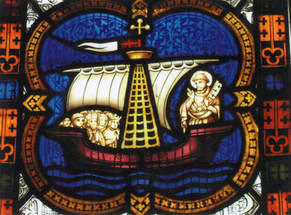
Catriona Blaker discusses Pugin’s thanksgiving for being kept safe at sea. September 15, 2018
Despite being shipwrecked in early youth Augustus Pugin maintained a lifelong love of the sea, selling his boat the Caroline only a few months before his death, according to Pugin scholar, Catriona Blaker. Speaking to an audience at St Augustine’s, Ramsgate, Blaker, co-founder of the Pugin Society, said he was fascinated by the sea and its dramas and cared deeply for its casualties often arranging medical care for the injured and funerals for those who died near his home. He often dressed in well worn sailor’s clothing.
“All his life Pugin deeply loved the sea and marine activities,” she said. “The subject of ships, wrecks and the sea makes an appropriate parallel to Pugin’s own turbulent and storm-tossed life.
“On a spiritual plane the sea brought souls for the Catholic church, mariners to worship at his own church of St Augustine and gave him the opportunity to exercise the charity and care for others he thought so important”. On a more mundane level, she added, in the years before Ramsgate had an official lifeboat Pugin would use his boats to rescue men, ships and cargo and the salvage money paid would go towards building his church, St Augustine’s.
After he was shipwrecked in early life Pugin was said to have crawled to a cottage where the woman of the house fed him, let him sleep and dried his clothes. He sent her a Christmas hamper regularly thereafter. Although the experience never stopped him buying boats or sailing it left him in awe of the sea, Blaker explained. “Only the ignorant despise the dangers of the sea,”Pugin is reported to have remarked.
At the age of 26, in 1838, Pugin gave a set of candlesticks to Oscott College Chapel, Bimingham, as an offering of thanks for delivery from a violent storm, Blaker explained. The candlesticks are inscribed with the words “sospes ex turbidine et diris fulminibus” meaning “saved from troubles and fearful thunderbolts and disasters”, she said.
Despite being shipwrecked in early youth Augustus Pugin maintained a lifelong love of the sea, selling his boat the Caroline only a few months before his death, according to Pugin scholar, Catriona Blaker. Speaking to an audience at St Augustine’s, Ramsgate, Blaker, co-founder of the Pugin Society, said he was fascinated by the sea and its dramas and cared deeply for its casualties often arranging medical care for the injured and funerals for those who died near his home. He often dressed in well worn sailor’s clothing.
“All his life Pugin deeply loved the sea and marine activities,” she said. “The subject of ships, wrecks and the sea makes an appropriate parallel to Pugin’s own turbulent and storm-tossed life.
“On a spiritual plane the sea brought souls for the Catholic church, mariners to worship at his own church of St Augustine and gave him the opportunity to exercise the charity and care for others he thought so important”. On a more mundane level, she added, in the years before Ramsgate had an official lifeboat Pugin would use his boats to rescue men, ships and cargo and the salvage money paid would go towards building his church, St Augustine’s.
After he was shipwrecked in early life Pugin was said to have crawled to a cottage where the woman of the house fed him, let him sleep and dried his clothes. He sent her a Christmas hamper regularly thereafter. Although the experience never stopped him buying boats or sailing it left him in awe of the sea, Blaker explained. “Only the ignorant despise the dangers of the sea,”Pugin is reported to have remarked.
At the age of 26, in 1838, Pugin gave a set of candlesticks to Oscott College Chapel, Bimingham, as an offering of thanks for delivery from a violent storm, Blaker explained. The candlesticks are inscribed with the words “sospes ex turbidine et diris fulminibus” meaning “saved from troubles and fearful thunderbolts and disasters”, she said.
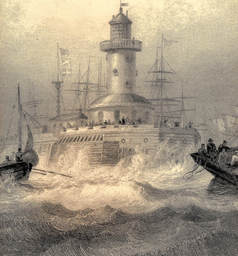
Pugin’s letters and diaries, many written from The Grange, his home on the Thanet coast, make frequent references to storms and shipping disasters.
“Everything is shaking and trembling and I have had two dying men to attend to from Spanish vessels- they were in the last state of exhaustion when brought ashore, he wrote in December 1847, “We must have a hospital here and three Sisters of Mercy - it is indispensable.” Two years later he describes the sinking of “one of our finest luggers” “Only one man saved. There are eight widows and 40 fatherless children. The distress is dreadful,” he wrote. Another entry from the same year recorded; “One emigrant ship for Antwerp and 171 persons lost last night on the long sand.”
Pugin bought his first boat, Elizabeth when he was 19 and went on a five day trip from Westminster to Gravesend and back with only one companion. Later he made trips to Holland and France to bring back antiques and furnishings. His last boat, Caroline, a three-masted Deal lugger, was bought in 1849 for £70 and was fitted out by Frederick Crace & Co, the royal decorators. The following year it salvaged 18 tons of Russian tallow – enough to pay for the damage caused by rocking scaffolding at the church, Pugin hoped.
But money remained a problem, expressed in maritime metaphor: “I know I am in a sinking ship and when I can no longer pump we go down,” Pugin wrote. He sold Caroline in early 1852 and died on September 14th the same year, the day after he visited St Augustine’s church for the last time.
“We can think of the significance to him of the Christian symbolism of the ship of the church, travelling on its turbulent way through the perils of life, but guided by the hand of God,” said Blaker.
Note: all quotes from Pugin’s letters cited here, with some amendments to punctuation, come from the invaluable five-volumes of these, edited by the late Margaret Belcher. Quotes from his diary come from Alexandra Wedgwood’s edited version included in AWN Pugin and the Pugin Family, Victoria & Albert Museum 1985.
“Everything is shaking and trembling and I have had two dying men to attend to from Spanish vessels- they were in the last state of exhaustion when brought ashore, he wrote in December 1847, “We must have a hospital here and three Sisters of Mercy - it is indispensable.” Two years later he describes the sinking of “one of our finest luggers” “Only one man saved. There are eight widows and 40 fatherless children. The distress is dreadful,” he wrote. Another entry from the same year recorded; “One emigrant ship for Antwerp and 171 persons lost last night on the long sand.”
Pugin bought his first boat, Elizabeth when he was 19 and went on a five day trip from Westminster to Gravesend and back with only one companion. Later he made trips to Holland and France to bring back antiques and furnishings. His last boat, Caroline, a three-masted Deal lugger, was bought in 1849 for £70 and was fitted out by Frederick Crace & Co, the royal decorators. The following year it salvaged 18 tons of Russian tallow – enough to pay for the damage caused by rocking scaffolding at the church, Pugin hoped.
But money remained a problem, expressed in maritime metaphor: “I know I am in a sinking ship and when I can no longer pump we go down,” Pugin wrote. He sold Caroline in early 1852 and died on September 14th the same year, the day after he visited St Augustine’s church for the last time.
“We can think of the significance to him of the Christian symbolism of the ship of the church, travelling on its turbulent way through the perils of life, but guided by the hand of God,” said Blaker.
Note: all quotes from Pugin’s letters cited here, with some amendments to punctuation, come from the invaluable five-volumes of these, edited by the late Margaret Belcher. Quotes from his diary come from Alexandra Wedgwood’s edited version included in AWN Pugin and the Pugin Family, Victoria & Albert Museum 1985.
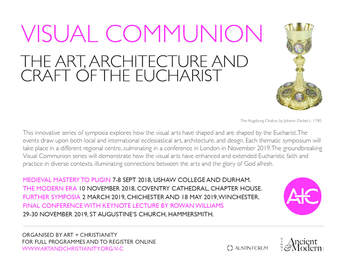
Art and Christianity lecture series to feature Rosemary Hill
Art and Christianity present a series of symposia entitled 'Visual Communion' on the art, architecture and craft of the Eucharist. The event features Rosemary Hill, society member and author of God's Architect: Pugin and the Building of Romantic Britain, who will give the keynote lecture on 'The brightness of returning glory': Pugin and the revival of Catholic architecture. Her lecture takes place 6pm on 7th September at Ushaw College. When booking, mention that you are with the Pugin Society to receive the concessionary rate. Click on the image above to enlarge, or click HERE to visit their website for more details.
Art and Christianity present a series of symposia entitled 'Visual Communion' on the art, architecture and craft of the Eucharist. The event features Rosemary Hill, society member and author of God's Architect: Pugin and the Building of Romantic Britain, who will give the keynote lecture on 'The brightness of returning glory': Pugin and the revival of Catholic architecture. Her lecture takes place 6pm on 7th September at Ushaw College. When booking, mention that you are with the Pugin Society to receive the concessionary rate. Click on the image above to enlarge, or click HERE to visit their website for more details.
Summary and photos of this year's Study Tour to Liverpool and the Wirral is now available HERE.
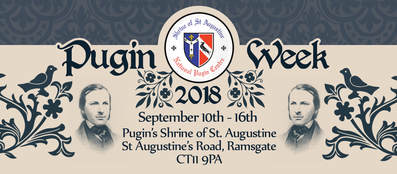
Details Released for Pugin Week 2018
Details are now available for this year's Pugin Week, held September 10-16 at the National Pugin Centre in St Augustine's Church, Ramsgate. This year features a series of lectures by Prof Michael Alexander on 'Pugin the Writer', Catriona Blaker of the Pugin Society on 'Pugin, Ramsgate and the Sea', Jayne Evelyn's compare and contrast of Pugin's Gothic Revival buildings and Ramsgate's Regency architecture, and Martin Renshaw and Dr Vicki Hardin on Pugin's question, 'Why don't they know how to use my building?' Fr Marcus will officiate Pugin's Requiem Mass in the chantry chapel, and will also give his final talk as Rector of St Augustine's where he'll share some reflections and stories of events leading to the creation of the National Pugin Centre and the Shrine of St Augustine. There are plenty of events not to be missed - for full details, including times and dates, see the event flyer HERE.
Details are now available for this year's Pugin Week, held September 10-16 at the National Pugin Centre in St Augustine's Church, Ramsgate. This year features a series of lectures by Prof Michael Alexander on 'Pugin the Writer', Catriona Blaker of the Pugin Society on 'Pugin, Ramsgate and the Sea', Jayne Evelyn's compare and contrast of Pugin's Gothic Revival buildings and Ramsgate's Regency architecture, and Martin Renshaw and Dr Vicki Hardin on Pugin's question, 'Why don't they know how to use my building?' Fr Marcus will officiate Pugin's Requiem Mass in the chantry chapel, and will also give his final talk as Rector of St Augustine's where he'll share some reflections and stories of events leading to the creation of the National Pugin Centre and the Shrine of St Augustine. There are plenty of events not to be missed - for full details, including times and dates, see the event flyer HERE.
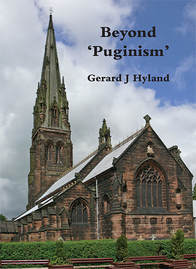
Gerard Hyland examines Pugin's approach to Liturgical Space
Published by Spire Books & The Pugin Society and based on the author's Pugin Lecture in Ramsgate in September 2017, this work addresses how AWN Pugin’s ecclesiology underwent a significant development in the later years of his life, the possible reasons for which are identified. After the opening of St Giles, Cheadle in 1846, Pugin started to experiment with various forms of asymmetry, and began to relax his earlier strict compliance with the rubrical requirements of the Use of Sarum. This was an implicit admission that his earlier conflation of Gothic with the Use of Sarum (‘Puginism’) had been flawed, and that Gothic could indeed be validly used in the service of the Tridentine Rite that was then normative in England. He made proposals as to how the ‘all seeing, all hearing’ liturgy that the Council of Trent had sought to promote could be facilitated by reconfiguring the chancels of Gothic churches. Copies can be ordered from Spire Books, South Barn, Old Standlynch Farm, Downton, Salisbury SP5 3QR
Price £14.95, cheques payable to J.P & D Elliott. It can also be ordered via Amazon. Author Gerard Hyland is set to lead the Pugin Society's summer study tour on The Gothic Revival in Liverpool and the Wirral. Find out details and book your place HERE.
Published by Spire Books & The Pugin Society and based on the author's Pugin Lecture in Ramsgate in September 2017, this work addresses how AWN Pugin’s ecclesiology underwent a significant development in the later years of his life, the possible reasons for which are identified. After the opening of St Giles, Cheadle in 1846, Pugin started to experiment with various forms of asymmetry, and began to relax his earlier strict compliance with the rubrical requirements of the Use of Sarum. This was an implicit admission that his earlier conflation of Gothic with the Use of Sarum (‘Puginism’) had been flawed, and that Gothic could indeed be validly used in the service of the Tridentine Rite that was then normative in England. He made proposals as to how the ‘all seeing, all hearing’ liturgy that the Council of Trent had sought to promote could be facilitated by reconfiguring the chancels of Gothic churches. Copies can be ordered from Spire Books, South Barn, Old Standlynch Farm, Downton, Salisbury SP5 3QR
Price £14.95, cheques payable to J.P & D Elliott. It can also be ordered via Amazon. Author Gerard Hyland is set to lead the Pugin Society's summer study tour on The Gothic Revival in Liverpool and the Wirral. Find out details and book your place HERE.
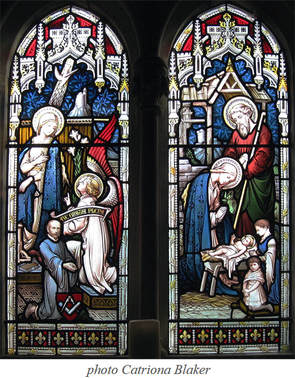
Gothic Revival Dublin home built by AWN Pugin’s son-in-law on market for £8.1million
A large seaside home in Killiney, built by the Irish architect George Ashlin, who was married to AWN Pugin’s daughter, Mary, and was in partnership with Edward Pugin, has been put up for sale for £8,125,524.
St George’s, overlooking Dublin Bay, built in 1876, nine years after Ashlin married Mary Pugin, includes a small oratory “believed to have been added in thanksgiving after the Ashlins were blessed with a daughter after ten years of marriage,” according to The Irish Times. There are monograms and heraldic symbols commemorating the Ashlins and the Pugins on almost every natural material in the house, describing it as “the ultimate bespoke home…a fascinating link to two ecclesiastical architects who left an indelible legacy on our built heritage”.
Ashlin, who died in the house in 1921, also built Clongowes Wood, the Jesuit school attended by James Joyce, and the cathedral in Cobh (with Edward Pugin). The house includes five bedrooms, four bathrooms, and “almost every room in St George’s bears the initials of the occupants, be it in the fireplaces, the delicate stained glass windows or on the monogrammed brass handles on every door”.
A large seaside home in Killiney, built by the Irish architect George Ashlin, who was married to AWN Pugin’s daughter, Mary, and was in partnership with Edward Pugin, has been put up for sale for £8,125,524.
St George’s, overlooking Dublin Bay, built in 1876, nine years after Ashlin married Mary Pugin, includes a small oratory “believed to have been added in thanksgiving after the Ashlins were blessed with a daughter after ten years of marriage,” according to The Irish Times. There are monograms and heraldic symbols commemorating the Ashlins and the Pugins on almost every natural material in the house, describing it as “the ultimate bespoke home…a fascinating link to two ecclesiastical architects who left an indelible legacy on our built heritage”.
Ashlin, who died in the house in 1921, also built Clongowes Wood, the Jesuit school attended by James Joyce, and the cathedral in Cobh (with Edward Pugin). The house includes five bedrooms, four bathrooms, and “almost every room in St George’s bears the initials of the occupants, be it in the fireplaces, the delicate stained glass windows or on the monogrammed brass handles on every door”.
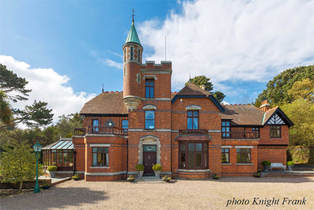
The house, visited by the Pugin Society on its Irish study tour, led by Alistair Rowan and Roderick O’Donnell in 2010, has been lived in for almost 30 years by Drs Robert and Jane McQuillan. They moved in when there was no central heating and the moulded woodwork had been painted over.
“The condition was fairly devastating and the grounds were just a spongey carpet of weeds but we knew it was a lovely house with a wonderful view and could be brought back to life The architecture and woodwork were great, ” Dr Jane McQuillan, an opthalmologist told the Pugin Society this week. “It took a lot more work than we expected but it’s been a very happy house with parties and christenings and we hope to have a Mass in the oratory before we leave,” she added. “But we’re both about 70 now and it’s time to move on.”
Mary, the longest surviving of Pugin’s eight children died at the age of 90 in 1933. Miriam Frances Ashlin, her only child, died in 1937. St George’s is being marketed by Knight Frank.
“The condition was fairly devastating and the grounds were just a spongey carpet of weeds but we knew it was a lovely house with a wonderful view and could be brought back to life The architecture and woodwork were great, ” Dr Jane McQuillan, an opthalmologist told the Pugin Society this week. “It took a lot more work than we expected but it’s been a very happy house with parties and christenings and we hope to have a Mass in the oratory before we leave,” she added. “But we’re both about 70 now and it’s time to move on.”
Mary, the longest surviving of Pugin’s eight children died at the age of 90 in 1933. Miriam Frances Ashlin, her only child, died in 1937. St George’s is being marketed by Knight Frank.
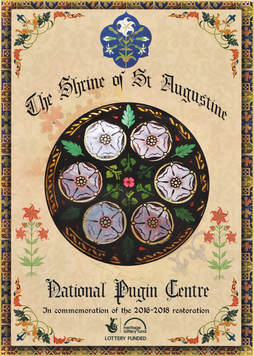
Restoration of AWN Pugin’s church inspirational says architect’s great great grandson
The £2 million restoration of St Augustine’s Ramsgate is a fitting tribute to AWN Pugin’s beliefs and values, and an inspiration to future generations, Robert Pugin Purcell told a celebration in the church on June 8th to mark the completion of the two year project, funded by Heritage London Fund grants, and donations.
A descendant of AWN Pugin and his third wife, Jane Knill, who outlived him by 55 years, Robert said: “Pugin described this church as ‘my own child’. For many years he had to build church after church, cathedral after cathedral according to other people’s wishes. This was his ‘ideal’ that he could build as he wished according to true principles of Christian architecture.
“I imagine that little did he realise that it would, in 2018, be a church and monument of such historical importance and great architectural, artistic and cultural significance. Pugin would have been so proud of what has been achieved.”
Threatened with closure in 2010 St Augustine’s was now welcoming 12,000 visitors a year, Father Marcus Holden, rector of St Augustine’s told the celebration, which was attended by restoration architect Paul Sharrock, Bishop Paul Mason of Southwark Archdiocese, and Craig Mackinlay MP for South Thanet, who unveiled a plaque in the adjacent visitor and research centre.
Catriona Blaker, co-founder of the Pugin Society, established in 1995, remembered the dark days when the church was rarely opened, its condition deteriorating and its future very uncertain indeed. “I recall sometimes sitting at the back of the nave on winter Sunday afternoons in a desperate bid to keep the church open for anyone who might want to see it. The lighting and heating had both failed, and muffled in much winter clothing one would stare in the gathering gloom at the High Altar, which at that time stood under the crossing, draped in polythene on to which water steadily dripped from the roof. Dark days indeed.”
In some ways, she said, the Pugin Society’s role was akin to John the Baptist’s preparing the way for a saviour – one had been found. “Father Marcus Holden with his drive, vision and ability to motivate others has achieved something nigh impossible.
“Knowledge of Pugin has grown an hundred fold and it is wonderful that our man Augustus Pugin has been so fully justified and celebrated,” she said.
The £2 million restoration of St Augustine’s Ramsgate is a fitting tribute to AWN Pugin’s beliefs and values, and an inspiration to future generations, Robert Pugin Purcell told a celebration in the church on June 8th to mark the completion of the two year project, funded by Heritage London Fund grants, and donations.
A descendant of AWN Pugin and his third wife, Jane Knill, who outlived him by 55 years, Robert said: “Pugin described this church as ‘my own child’. For many years he had to build church after church, cathedral after cathedral according to other people’s wishes. This was his ‘ideal’ that he could build as he wished according to true principles of Christian architecture.
“I imagine that little did he realise that it would, in 2018, be a church and monument of such historical importance and great architectural, artistic and cultural significance. Pugin would have been so proud of what has been achieved.”
Threatened with closure in 2010 St Augustine’s was now welcoming 12,000 visitors a year, Father Marcus Holden, rector of St Augustine’s told the celebration, which was attended by restoration architect Paul Sharrock, Bishop Paul Mason of Southwark Archdiocese, and Craig Mackinlay MP for South Thanet, who unveiled a plaque in the adjacent visitor and research centre.
Catriona Blaker, co-founder of the Pugin Society, established in 1995, remembered the dark days when the church was rarely opened, its condition deteriorating and its future very uncertain indeed. “I recall sometimes sitting at the back of the nave on winter Sunday afternoons in a desperate bid to keep the church open for anyone who might want to see it. The lighting and heating had both failed, and muffled in much winter clothing one would stare in the gathering gloom at the High Altar, which at that time stood under the crossing, draped in polythene on to which water steadily dripped from the roof. Dark days indeed.”
In some ways, she said, the Pugin Society’s role was akin to John the Baptist’s preparing the way for a saviour – one had been found. “Father Marcus Holden with his drive, vision and ability to motivate others has achieved something nigh impossible.
“Knowledge of Pugin has grown an hundred fold and it is wonderful that our man Augustus Pugin has been so fully justified and celebrated,” she said.
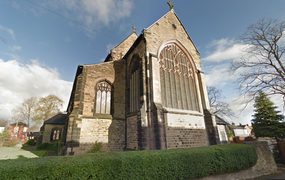
Pugin's St Alban's, Macclesfield Receives a Much Needed Grant for Repairs
As reported by the National Churches Trust, £425,183 in grant money has been allocated to 55 churches and chapels, including St Alban's in Macclesfield. Built in 1841, the church is listed as Grade II* by National Heritage for England. The National Churches Trust Repair Grant will help address urgent roof repairs.
Also receiving funding is St Mary's, Beverley, for whom AW Pugin and EW Pugin supervised restoration efforts, and St Mary's, Lanark, whose reredos, Lady Chapel, and high altar were installed by Pugin and Pugin.
As reported by the National Churches Trust, £425,183 in grant money has been allocated to 55 churches and chapels, including St Alban's in Macclesfield. Built in 1841, the church is listed as Grade II* by National Heritage for England. The National Churches Trust Repair Grant will help address urgent roof repairs.
Also receiving funding is St Mary's, Beverley, for whom AW Pugin and EW Pugin supervised restoration efforts, and St Mary's, Lanark, whose reredos, Lady Chapel, and high altar were installed by Pugin and Pugin.
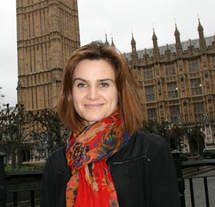
Pugin Wallpaper in V&A Memorial Trail
A wallpaper designed by AWN Pugin for the Palace of Westminster is featured in a trail established at the Victoria and Albert Museum, London, in memory of the murdered MP, Jo Cox. Labour member for Batley and Spen, Jo was murdered in Yorkshire by a right wing extremist in June 2016. Blogging about the trail Tristram Hunt, director of the V&A, said Jo was “a dedicated internationalist, passionate campaigner for social justice, brilliant MP and loving mother. Visitors will be taken on a journey through the museum to discover objects which speak to her life story and values.... From Augustus Pugin’s distinctive Parliament Wallpaper, to an eighteenth century anti-slavery medallion highlighting Jo’s humanitarian work in conflict zones, or a Thomas Creswick painting of Perthshire representing her love of the great British outdoors, our object trail offers a thought-provoking contemplation of the myriad layers of Jo’s inspirational personality and life.” The medallion featured was made for the Society for the Abolition of the Slave Trade, made at Josiah Wedgwood’s factory, Etruria, Staffordshire, about 1787. Historian Tristram Hunt, former Labour MP for Stoke-on-Trent Central, spoke on Pugin, medievalism and modernity, at a Pugin Society reception in the House of Commons in March 2012, to mark the architect’s bicentenary. View details of the trail HERE.
A wallpaper designed by AWN Pugin for the Palace of Westminster is featured in a trail established at the Victoria and Albert Museum, London, in memory of the murdered MP, Jo Cox. Labour member for Batley and Spen, Jo was murdered in Yorkshire by a right wing extremist in June 2016. Blogging about the trail Tristram Hunt, director of the V&A, said Jo was “a dedicated internationalist, passionate campaigner for social justice, brilliant MP and loving mother. Visitors will be taken on a journey through the museum to discover objects which speak to her life story and values.... From Augustus Pugin’s distinctive Parliament Wallpaper, to an eighteenth century anti-slavery medallion highlighting Jo’s humanitarian work in conflict zones, or a Thomas Creswick painting of Perthshire representing her love of the great British outdoors, our object trail offers a thought-provoking contemplation of the myriad layers of Jo’s inspirational personality and life.” The medallion featured was made for the Society for the Abolition of the Slave Trade, made at Josiah Wedgwood’s factory, Etruria, Staffordshire, about 1787. Historian Tristram Hunt, former Labour MP for Stoke-on-Trent Central, spoke on Pugin, medievalism and modernity, at a Pugin Society reception in the House of Commons in March 2012, to mark the architect’s bicentenary. View details of the trail HERE.

New Appointment at St Augustine's Ramsgate
The Pugin Society is pleased to see Father Simon Heans now in post as the new Manager of the St Augustine and Pugin Education, Research and Visitor Centre at Pugin’s shrine church of St Augustine in Ramsgate. He will be continuing the good work started here by previous Manager John Coverdale over the last three years. Subsequent to obtaining a History degree from Peterhouse, Cambridge, Father Simon began to teach from 1980 onwards, notably at Lancing College, Sussex (a feast of Gothic Revival buildings, in particular the sensational chapel, mostly the work of ‘The Anglican Pugin’ R H Carpenter), and then took orders as an Anglican priest. Eventually, however, he moved over in 2011 to the Catholic church, through the Personal Ordinariate of Our Lady of Walsingham, thereafter working as a chaplain, first in a Catholic comprehensive and subsequently in a remand prison. Father Simon’s varied experience, his commitment to Pugin, church history, scholarship and Catholicism (others may wish to adjust the order here) make him just the man for the job. We hope that he and his wife Anne and family will enjoy life in East Kent and we wish him every success.
The Pugin Society is pleased to see Father Simon Heans now in post as the new Manager of the St Augustine and Pugin Education, Research and Visitor Centre at Pugin’s shrine church of St Augustine in Ramsgate. He will be continuing the good work started here by previous Manager John Coverdale over the last three years. Subsequent to obtaining a History degree from Peterhouse, Cambridge, Father Simon began to teach from 1980 onwards, notably at Lancing College, Sussex (a feast of Gothic Revival buildings, in particular the sensational chapel, mostly the work of ‘The Anglican Pugin’ R H Carpenter), and then took orders as an Anglican priest. Eventually, however, he moved over in 2011 to the Catholic church, through the Personal Ordinariate of Our Lady of Walsingham, thereafter working as a chaplain, first in a Catholic comprehensive and subsequently in a remand prison. Father Simon’s varied experience, his commitment to Pugin, church history, scholarship and Catholicism (others may wish to adjust the order here) make him just the man for the job. We hope that he and his wife Anne and family will enjoy life in East Kent and we wish him every success.
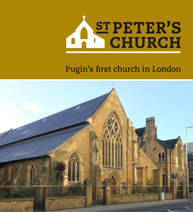
St Peter's, Woolwich, benefits from Heritage Lottery Funds
Congratulations to everyone at Pugin's St Peter's Church, Woolwich, for all that they have done, with help from the Heritage Lottery Fund, to restore and promote St Peter's. They have shared a leaflet about the church's history and restoration, making it available to view online. We hope that anyone looking at this website and reading the church's leaflet will feel inspired to visit this interesting church for themselves, or even perhaps to offer help or support in some way. To view St Peter's leaflet, click HERE.
Congratulations to everyone at Pugin's St Peter's Church, Woolwich, for all that they have done, with help from the Heritage Lottery Fund, to restore and promote St Peter's. They have shared a leaflet about the church's history and restoration, making it available to view online. We hope that anyone looking at this website and reading the church's leaflet will feel inspired to visit this interesting church for themselves, or even perhaps to offer help or support in some way. To view St Peter's leaflet, click HERE.
MPs agree to full decant for Parliament's restoration and renewal
After several hours of debate, MPs voted to leave the Houses of Parliament for the much needed commencement of the restoration and renewal project. Although the full decant is not expected to take place until 2025, this is a step in the right direction. Thank you to all who contacted their representatives to advocate for these much needed repairs. The Guardian provides a concise outline of the vote. However, if you would like to (re)view the proceedings, click HERE and forward to 15:55:11 for the start of the debate.
May we also suggest that you follow The Pugin Society on Facebook where we update and share the latest on the Houses of Parliament and other Pugin-related issues? We hope you will join us there.
After several hours of debate, MPs voted to leave the Houses of Parliament for the much needed commencement of the restoration and renewal project. Although the full decant is not expected to take place until 2025, this is a step in the right direction. Thank you to all who contacted their representatives to advocate for these much needed repairs. The Guardian provides a concise outline of the vote. However, if you would like to (re)view the proceedings, click HERE and forward to 15:55:11 for the start of the debate.
May we also suggest that you follow The Pugin Society on Facebook where we update and share the latest on the Houses of Parliament and other Pugin-related issues? We hope you will join us there.
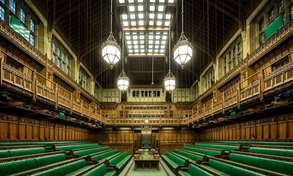
MPs to Vote on Vacating Parliament for Renovation Works
MPs are set to hold a free vote in the Commons to determine what, if anything, will be done regarding the much-needed restoration of the Houses of Parliament. However, The Guardian reports that "some [MPs] say [the] move out of Palace of Westminster for multibillion-pound restoration [is] unnecessary."
MPs will consider the folllowing options:
• Full decant. Commons and Lords both move out of the Palace of Westminster to buildings nearby while total renovation works take place. Estimated cost: £3.5bn over six years.
• Partial decant. Move the Commons off site first, then the Lords, renovating each in turn. Estimated cost: £4.4bn over 11 years.
• Refurbish on site. Commons and Lords chambers would still have to move, probably to Westminster Hall, during a rolling programme of upgrade works. Estimated cost: £5.7bn over 35 years.
Now would be a good time to contact your MP to express your support for the full and immediate restoration of this historic national treasure.
MPs are set to hold a free vote in the Commons to determine what, if anything, will be done regarding the much-needed restoration of the Houses of Parliament. However, The Guardian reports that "some [MPs] say [the] move out of Palace of Westminster for multibillion-pound restoration [is] unnecessary."
MPs will consider the folllowing options:
• Full decant. Commons and Lords both move out of the Palace of Westminster to buildings nearby while total renovation works take place. Estimated cost: £3.5bn over six years.
• Partial decant. Move the Commons off site first, then the Lords, renovating each in turn. Estimated cost: £4.4bn over 11 years.
• Refurbish on site. Commons and Lords chambers would still have to move, probably to Westminster Hall, during a rolling programme of upgrade works. Estimated cost: £5.7bn over 35 years.
Now would be a good time to contact your MP to express your support for the full and immediate restoration of this historic national treasure.
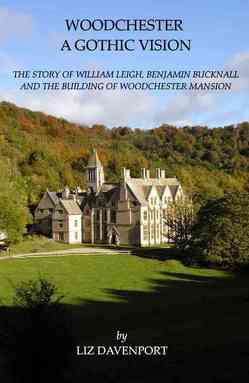
Woodchester: A Gothic Vision - Liz Davenport's book includes Pugin's work at Woodchester Mansion
This informative publication regales the reader with an account not only of the history and construction of Woodchester Mansion itself but also of the building of the Catholic Church of the Annunciation and the Dominican Priory at South Woodchester, all part of the vision of the Catholic convert owner of the estate, William Leigh. We in the Pugin Society are only too familiar with tales of ambitious projects such as this, undertaken by highly motivated, devout and wealthy (at the time) Catholics and converts, and of their often melancholy endings. Examples such as Alton Towers, for the sixteenth Earl of Shrewsbury, Croston Hall in Lancashire for the de Trafford family, and Garendon in Leicestershire for Ambrose March Phillips de Lisle spring to mind. Perhaps a major difference in this instance is that whilst the aforesaid buildings are either now demolished, or much reduced, Woodchester Mansion has only ever existed as an unfinished building, and this, as author Liz Davenport suggests, has perhaps helped to make its continued existence possible. Its significance is indeed in its bare and incomplete state, and it is in this haunting and now lovingly conserved condition that visitors can see it. This was made possible by the serving of a compulsory purchase order on the house by Stroud District Council in 1987 and the formation of the Woodchester Mansion Trust in the following year.
Two architects worked for Leigh at Woodchester, C F Hansom and, in particular, the young Benjamin Bucknall, but a third architect was also temporarily involved – Augustus Pugin, and it is his connection with William Leigh that makes this book of particular interest to readers of Present State. Ultimately, Pugin cried off, having produced a plan of the new proposed residence, which was to replace the existing Spring Park Mansion, and two elevations, plus, also, external and internal drawings of the Church of the Annunciation. However, problems regarding the proposed site for the church and the ambitious size of the Dominican Priory which Leigh wanted, and the difficulties of keeping the commission to a budget that was possible for him, became too much for Pugin. He was extremely busy elsewhere also, and in 1846 his personal life was in a state of disarray. The Catholic architect C F Hansom, for professional reasons not one of Pugin’s favourite people, took over and also started work on Woodchester Mansion itself, but not for long. Hansom’s youthful assistant Benjamin Bucknall who, like Leigh, had a great admiration for the great French revivalist Viollet-le-Duc, soon assumed control, designing an outstanding mansion and chapel, a fine example of Victorian Gothic with references to the style of Viollet here and there, both structurally and in some of the detail. Because Leigh’s money ran out and his family, despite various efforts on their part, never really managed to improve satisfactorily upon this situation, the great house remained unfinished; after 1873 when William Leigh died, work came to a standstill. It is this which gives Woodchester its allure, and which it makes possible today to study the raw bones of its original and skilled design, as indeed members of the Pugin Society did when they visited in summer 2010.
The book also covers the history of William Leigh’s antecedents and the reasons for his initial wealth, and goes on to recount the problems of his son Willie and others who inherited Woodchester. The family retained the estate until 1939, after which it went through some difficult periods, until as, mentioned above, the enterprising and energetic Woodchester Mansion Trust was formed. Author Liz Davenport, who has dedicated this book to her co-volunteers at Woodchester, is the Trust’s archivist, and they are lucky to have her. Helped particularly by a rich archive, discovered in Brighton in 2004, and other local sources she has done a thorough and professional job here, with much careful research, referencing and illustrations. This is a fascinating account. Buy it online – all proceeds go the Woodchester Mansion Trust – and, if you can, visit the mansion in its unspoilt and verdant park setting.
This informative publication regales the reader with an account not only of the history and construction of Woodchester Mansion itself but also of the building of the Catholic Church of the Annunciation and the Dominican Priory at South Woodchester, all part of the vision of the Catholic convert owner of the estate, William Leigh. We in the Pugin Society are only too familiar with tales of ambitious projects such as this, undertaken by highly motivated, devout and wealthy (at the time) Catholics and converts, and of their often melancholy endings. Examples such as Alton Towers, for the sixteenth Earl of Shrewsbury, Croston Hall in Lancashire for the de Trafford family, and Garendon in Leicestershire for Ambrose March Phillips de Lisle spring to mind. Perhaps a major difference in this instance is that whilst the aforesaid buildings are either now demolished, or much reduced, Woodchester Mansion has only ever existed as an unfinished building, and this, as author Liz Davenport suggests, has perhaps helped to make its continued existence possible. Its significance is indeed in its bare and incomplete state, and it is in this haunting and now lovingly conserved condition that visitors can see it. This was made possible by the serving of a compulsory purchase order on the house by Stroud District Council in 1987 and the formation of the Woodchester Mansion Trust in the following year.
Two architects worked for Leigh at Woodchester, C F Hansom and, in particular, the young Benjamin Bucknall, but a third architect was also temporarily involved – Augustus Pugin, and it is his connection with William Leigh that makes this book of particular interest to readers of Present State. Ultimately, Pugin cried off, having produced a plan of the new proposed residence, which was to replace the existing Spring Park Mansion, and two elevations, plus, also, external and internal drawings of the Church of the Annunciation. However, problems regarding the proposed site for the church and the ambitious size of the Dominican Priory which Leigh wanted, and the difficulties of keeping the commission to a budget that was possible for him, became too much for Pugin. He was extremely busy elsewhere also, and in 1846 his personal life was in a state of disarray. The Catholic architect C F Hansom, for professional reasons not one of Pugin’s favourite people, took over and also started work on Woodchester Mansion itself, but not for long. Hansom’s youthful assistant Benjamin Bucknall who, like Leigh, had a great admiration for the great French revivalist Viollet-le-Duc, soon assumed control, designing an outstanding mansion and chapel, a fine example of Victorian Gothic with references to the style of Viollet here and there, both structurally and in some of the detail. Because Leigh’s money ran out and his family, despite various efforts on their part, never really managed to improve satisfactorily upon this situation, the great house remained unfinished; after 1873 when William Leigh died, work came to a standstill. It is this which gives Woodchester its allure, and which it makes possible today to study the raw bones of its original and skilled design, as indeed members of the Pugin Society did when they visited in summer 2010.
The book also covers the history of William Leigh’s antecedents and the reasons for his initial wealth, and goes on to recount the problems of his son Willie and others who inherited Woodchester. The family retained the estate until 1939, after which it went through some difficult periods, until as, mentioned above, the enterprising and energetic Woodchester Mansion Trust was formed. Author Liz Davenport, who has dedicated this book to her co-volunteers at Woodchester, is the Trust’s archivist, and they are lucky to have her. Helped particularly by a rich archive, discovered in Brighton in 2004, and other local sources she has done a thorough and professional job here, with much careful research, referencing and illustrations. This is a fascinating account. Buy it online – all proceeds go the Woodchester Mansion Trust – and, if you can, visit the mansion in its unspoilt and verdant park setting.
|
Remembering Gavin Stamp
The Society is sad to learn that the architectural historian and conservationist Gavin Stamp passed away on the 30th December. A long-time supporter of the Pugin Society, Gavin was active in leading outings and contributing his vast insight to True Principles. Committee members Catriona Blaker and Julia Twigg discuss his lasting impact on the Pugin Society and the architectural community at large HERE. |
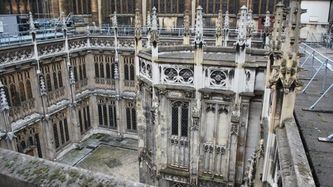
The Houses of Parliament's 'Restoration and Renewal' plan delayed once again
News that the decision on how to proceed with the 'Restoration and Renewal' plan is set to be postponed for 18 months comes as a bitter blow to those who realise that, as the BBC states, "the buildings of the Palace of Westminster are deteriorating faster than running repairs can be made" and that when work does begin, the cost will undoubtedly have risen.
For an idea of the current state of the building, read "Fires, floods and mice: What it's like to work in a crumbling Parliament" and be sure to have tissues at hand as the enormity of the situation is laid bare. One can only wonder why those elected officials who are privileged enough to work in this iconic building and act as its guardians are the last to realize the pressing urgency of the task at hand, for the 'Restoration and Renewal' is soon to turn to rubble and ruin if action is not taken.
News that the decision on how to proceed with the 'Restoration and Renewal' plan is set to be postponed for 18 months comes as a bitter blow to those who realise that, as the BBC states, "the buildings of the Palace of Westminster are deteriorating faster than running repairs can be made" and that when work does begin, the cost will undoubtedly have risen.
For an idea of the current state of the building, read "Fires, floods and mice: What it's like to work in a crumbling Parliament" and be sure to have tissues at hand as the enormity of the situation is laid bare. One can only wonder why those elected officials who are privileged enough to work in this iconic building and act as its guardians are the last to realize the pressing urgency of the task at hand, for the 'Restoration and Renewal' is soon to turn to rubble and ruin if action is not taken.
Caroline Shenton warns "Big Ben is falling silent. It's our final warning to save the Houses of Parliament."
As restoration work on Big Ben gets underway, former Parliamentary Archives director and scheduled speaker for the Pugin Society's 2017 AGM Caroline Shenton writes in The Guardian that unless something is done "The Palace will either suffer a major catastrophe such as a fire similar to the one which burned down the old Houses of Parliament in 1834, or a series of cumulative smaller failures...which will bring the infrastructure of the Palace to a standstill, or cause irreparable damage to Charles Barry and AWN Pugin’s masterpiece." Read the full article HERE and urge your MP to address this impending crisis before it is too late.
As restoration work on Big Ben gets underway, former Parliamentary Archives director and scheduled speaker for the Pugin Society's 2017 AGM Caroline Shenton writes in The Guardian that unless something is done "The Palace will either suffer a major catastrophe such as a fire similar to the one which burned down the old Houses of Parliament in 1834, or a series of cumulative smaller failures...which will bring the infrastructure of the Palace to a standstill, or cause irreparable damage to Charles Barry and AWN Pugin’s masterpiece." Read the full article HERE and urge your MP to address this impending crisis before it is too late.
2017
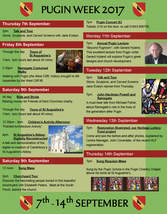
Pugin Week 7th-14th September 2017
Details of this year's Pugin Week have been announced, with tours, lectures, and events on Pugin's work offer. From Thursday the 7th September to Thursday the 14th, visitors can experience a wide variety of free Pugin-themed activities. The Pugin Society is especially looking forward to 'Beyond Puginism', member Gerard Hyland's lecture on the 11th. All events are held in Pugin's home town of Ramsgate at the National Pugin Centre at St Augustine's, CT11 9NY. View the full size poster HERE for details of this annual celebration of all things Pugin.
Details of this year's Pugin Week have been announced, with tours, lectures, and events on Pugin's work offer. From Thursday the 7th September to Thursday the 14th, visitors can experience a wide variety of free Pugin-themed activities. The Pugin Society is especially looking forward to 'Beyond Puginism', member Gerard Hyland's lecture on the 11th. All events are held in Pugin's home town of Ramsgate at the National Pugin Centre at St Augustine's, CT11 9NY. View the full size poster HERE for details of this annual celebration of all things Pugin.
|
The Pugin Society featured in the latest journal of the Society of Architectural Historians of Great Britain
The Architectural Historian, the journal of the Society of Architectural Historians of Great Britain, has featured True Principles in their August 2017 issue. The SAHGB has graciously granted us permission to share this with those of you who may have missed it. Click HERE to download the PDF |
Gavin Stamp tells Apollo magazine "Big Ben is the least of the Palace of Westminster's problems"
The number of scholars speaking out about the failure to address structural issues at the Houses of Parliament is growing following the silencing of Big Ben. Professor Gavin Stamp's article in Apollo magazine reiterates the urgency with which these issues need to be addressed. Read his article HERE and join Stamp on the 23rd September for the society outing to see the work of great Gothic Revivalist and admirer of Pugin, George Gilbert Scott. Visit our EVENTS page for further details.
The number of scholars speaking out about the failure to address structural issues at the Houses of Parliament is growing following the silencing of Big Ben. Professor Gavin Stamp's article in Apollo magazine reiterates the urgency with which these issues need to be addressed. Read his article HERE and join Stamp on the 23rd September for the society outing to see the work of great Gothic Revivalist and admirer of Pugin, George Gilbert Scott. Visit our EVENTS page for further details.
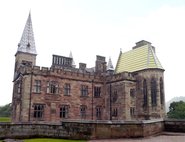
Open Day at Alton Castle and St. John's Church Saturday 8 July
One of our followers posted this on the Pugin Society's Facebook Page and we thought it would be worth sharing here as well. Pugin's St. John the Baptist Church and Alton Castle are hosting a Garden Party and Open House. While the day features a host of events for the family, Society members will be especially interested in the guided tours of Alton Castle and St John the Baptist church available that day. Admission is £1 and all proceeds from the event will go towards St John the Baptist Roman Catholic Church and to Alton Castle. See the event flyer HERE and join us on facebook to see these events as they're posted.
One of our followers posted this on the Pugin Society's Facebook Page and we thought it would be worth sharing here as well. Pugin's St. John the Baptist Church and Alton Castle are hosting a Garden Party and Open House. While the day features a host of events for the family, Society members will be especially interested in the guided tours of Alton Castle and St John the Baptist church available that day. Admission is £1 and all proceeds from the event will go towards St John the Baptist Roman Catholic Church and to Alton Castle. See the event flyer HERE and join us on facebook to see these events as they're posted.
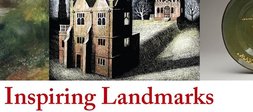
Inspiring Landmarks - Art inspired by The Landmark Trust
The Landmark Trust, saviours of Pugin's house, The Grange, in Ramsgate are having an exhibition illustrating how selected artists have reacted to various of Landmark's beautiful and interesting properties. Inspiring Landmarks, an exhibition of art by Prue Cooper, Kurt Jackson and Ed Kluz, runs from 29 June - 4 July at The Old Truman Brewery, Spitalfields, London. Perhaps some of Pugin's buildings might make an appearance? View the full programme HERE.
The Landmark Trust, saviours of Pugin's house, The Grange, in Ramsgate are having an exhibition illustrating how selected artists have reacted to various of Landmark's beautiful and interesting properties. Inspiring Landmarks, an exhibition of art by Prue Cooper, Kurt Jackson and Ed Kluz, runs from 29 June - 4 July at The Old Truman Brewery, Spitalfields, London. Perhaps some of Pugin's buildings might make an appearance? View the full programme HERE.
|
Gothic Revival Worldwide: A.W.N. Pugin's Global Influence book launch a success
On April 5, The Grange, Ramsgate, was the location of the book launch relating to the 2012 international conference New Directions in Gothic Revival Studies Worldwide. A sizeable crowd gathered to emjoy wine and refreshments while short talks were given by editor Tim Brittain-Catlin and Alexandra Wedgwood, to whom, along with the late Margaret Belcher, the volume is dedicated. Here are pictures showing the gathering and subsequent presentation of a copy to Pugin scholar Alexandra Wedgwood. These photos were posted from the event directly to our facebook page. Have you joined as a friend? Please do and access all our latest updates here: facebook.com/ThePuginSociety |
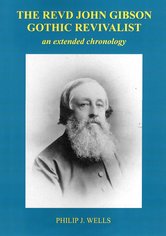
Publication of "The Revd John Gibson, Gothic Revivalist" by Philip J. Wells
Occasionally we receive news about a publication we feel our membership could appreciate. For that reason we are pleased to introduce the publication of Philip J. Wells’ “The Revd John Gibson, Gothic Revivalist – an Extended Chronology”. John Gibson (1815-1892) was born in Stratford, Essex and was in Cambridge in 1839 when the Cambridge Camden Society was formed with its emphasis on church architecture, decoration, liturgy and music. He was an artist and musician, had expert knowledge of ecclesiastical furniture and decoration, and specialised in organ cases. Throughout his career he worked with Pugin, Bodley and Burges; also Leach the decorator and Hardman and Morris for glass. This extended chronology seeks to chronicle Gibson’s life as history seems to have passed him by. Sale proceeds will support St George’s Church, King’s Stanley. Copies are available for £5.00, or £6.50 by post. Please contact/direct payment to Philip J. Wells, 80 Lantern Close, Berkeley, Gloucestershire. GL13 9DE
Occasionally we receive news about a publication we feel our membership could appreciate. For that reason we are pleased to introduce the publication of Philip J. Wells’ “The Revd John Gibson, Gothic Revivalist – an Extended Chronology”. John Gibson (1815-1892) was born in Stratford, Essex and was in Cambridge in 1839 when the Cambridge Camden Society was formed with its emphasis on church architecture, decoration, liturgy and music. He was an artist and musician, had expert knowledge of ecclesiastical furniture and decoration, and specialised in organ cases. Throughout his career he worked with Pugin, Bodley and Burges; also Leach the decorator and Hardman and Morris for glass. This extended chronology seeks to chronicle Gibson’s life as history seems to have passed him by. Sale proceeds will support St George’s Church, King’s Stanley. Copies are available for £5.00, or £6.50 by post. Please contact/direct payment to Philip J. Wells, 80 Lantern Close, Berkeley, Gloucestershire. GL13 9DE
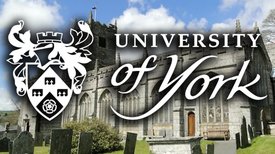
The University of York offers a Postgraduate Diploma in Parish Church Studies
The postgraduate diploma in Parish Church Studies offers a unique opportunity to gain detailed and practical knowledge of the history, use, care and conservation of parish churches. This two-year, part-time, postgraduate-level programme is delivered wholly online, offering the opportunity to study in your own home and somewhat at your own pace, extensively supported by an expert in the field, and learning as part of an active online community. For more information, click HERE.
The postgraduate diploma in Parish Church Studies offers a unique opportunity to gain detailed and practical knowledge of the history, use, care and conservation of parish churches. This two-year, part-time, postgraduate-level programme is delivered wholly online, offering the opportunity to study in your own home and somewhat at your own pace, extensively supported by an expert in the field, and learning as part of an active online community. For more information, click HERE.

The Pugin Society is now on Facebook
If you recognize these symbols then you know there's only one thing this can mean - we are now on Facebook! Pugin himself believed that one "should gladly avail himself of those improvements and increased facilities that are suggested from time to time" so why don't you come join us? We're lacking in followers at the moment, so we need fellow Pugin enthusiasts to 'friend' us and contribute to create a lively and dynamic community.
If you recognize these symbols then you know there's only one thing this can mean - we are now on Facebook! Pugin himself believed that one "should gladly avail himself of those improvements and increased facilities that are suggested from time to time" so why don't you come join us? We're lacking in followers at the moment, so we need fellow Pugin enthusiasts to 'friend' us and contribute to create a lively and dynamic community.
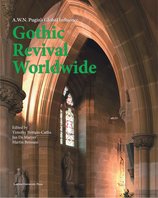
Gothic Revival Worldwide: A.W.N. Pugin's Global Influence book launched at The Grange, Ramsgate
On April 5, CREAte, the University of Kent School of Architecture’s humanities research centre, organised the launch to celebrate the publication of this latest volume of Pugin scholarship. Originating with the 2012 international conference New Directions in Gothic Revival Studies Worldwide, which attracted leading scholars from all over the globe, and which was organised by CREAte, with volunteer support from the Pugin Society, Gothic Revival Worldwide is set to become the authoritative volume on the history of the nineteenth-century Gothic Revival. Short talks were given by editor Tim Brittain-Catlin and Alexandra Wedgwood, to whom, along with the late Margaret Belcher, the book is dedicated.
On April 5, CREAte, the University of Kent School of Architecture’s humanities research centre, organised the launch to celebrate the publication of this latest volume of Pugin scholarship. Originating with the 2012 international conference New Directions in Gothic Revival Studies Worldwide, which attracted leading scholars from all over the globe, and which was organised by CREAte, with volunteer support from the Pugin Society, Gothic Revival Worldwide is set to become the authoritative volume on the history of the nineteenth-century Gothic Revival. Short talks were given by editor Tim Brittain-Catlin and Alexandra Wedgwood, to whom, along with the late Margaret Belcher, the book is dedicated.
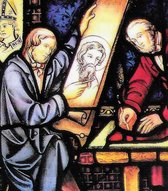
Book launch for Guarding the Pugin Flame: John Hardman Powell 1827-1895
The Pugin Society is pleased to announce of Michael Fisher's latest book on John Hardman Powell. The venue is St Chad's cathedral in Birmingham. There will be a talk in the cathedral by Michael and also brief words from Sarah Houle who is related to John Hardman Powell and a tribute to Margaret Belcher to whom the book is dedicated. After this complimentary refreshments will be served in the Grimshaw Room and you will have an opportunity to acquire a copy of the book should you so wish. Society members who would like to receive an invitation to the reception should contact Michael Fisher before 28 February. Please click HERE to see the attached flyer for details.
The Pugin Society is pleased to announce of Michael Fisher's latest book on John Hardman Powell. The venue is St Chad's cathedral in Birmingham. There will be a talk in the cathedral by Michael and also brief words from Sarah Houle who is related to John Hardman Powell and a tribute to Margaret Belcher to whom the book is dedicated. After this complimentary refreshments will be served in the Grimshaw Room and you will have an opportunity to acquire a copy of the book should you so wish. Society members who would like to receive an invitation to the reception should contact Michael Fisher before 28 February. Please click HERE to see the attached flyer for details.
2016
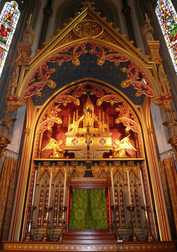
2016 Christmas Midnight Mass to be broadcast from St. Chad's Cathedral
Pugin's architecture will once again take centre stage this Christmas as the BBC announced its midnight mass service will be held at St. Chad's Cathedral in Birmingham. Built in 1841, it was the first Catholic Cathedral built in Britain since the end of the Reformation and is the resting place for Pugin's second wife Louisa as well as members of the Hardman family. The BBC chose another of Pugin's churches, St. George's Cathedral, Southwark, for last year's service. It is heartening to know that Pugin's splendour will once again be broadcast across the nation this Christmas.
Pugin's architecture will once again take centre stage this Christmas as the BBC announced its midnight mass service will be held at St. Chad's Cathedral in Birmingham. Built in 1841, it was the first Catholic Cathedral built in Britain since the end of the Reformation and is the resting place for Pugin's second wife Louisa as well as members of the Hardman family. The BBC chose another of Pugin's churches, St. George's Cathedral, Southwark, for last year's service. It is heartening to know that Pugin's splendour will once again be broadcast across the nation this Christmas.
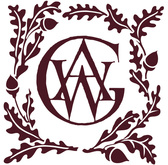
2016 AGM details announced
Full details of this year's AGM, to be held on December 10th at the Art Workers’ Guild, have been announced. As in previous years, the general meeting will be followed by a talk by Dr Kate Jordan titled 'Infernal minds: nuns, convent architecture and the Pugins', and a buffet lunch.
Full details of this year's AGM, to be held on December 10th at the Art Workers’ Guild, have been announced. As in previous years, the general meeting will be followed by a talk by Dr Kate Jordan titled 'Infernal minds: nuns, convent architecture and the Pugins', and a buffet lunch.
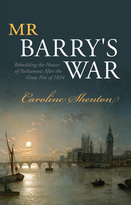
Caroline Shenton's Mr Barry's War on offer to Pugin Society Members
Society members may remember Ms Shenton's brilliant talk at the 2012 AGM on her award-winning The Day Parliament Burned Down. Its sequel, Mr Barry's War, is the story of the re-building of the Houses of Parliament after the great fire of 1834. Oxford University Press is offering a 30% discount on this latest publication, making this look at the construction of the New Palace of Westminster an offer that no Puginite can refuse. View the details and get the offer code HERE.
Society members may remember Ms Shenton's brilliant talk at the 2012 AGM on her award-winning The Day Parliament Burned Down. Its sequel, Mr Barry's War, is the story of the re-building of the Houses of Parliament after the great fire of 1834. Oxford University Press is offering a 30% discount on this latest publication, making this look at the construction of the New Palace of Westminster an offer that no Puginite can refuse. View the details and get the offer code HERE.
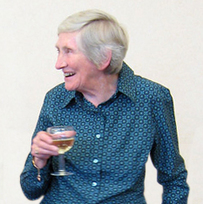
Remembering Margaret Belcher
The Society is sad to learn that the eminent Pugin scholar Dr. Margaret Belcher passed away on the 29th November following a short illness. Society members will know Margaret best for her works A.W.N. Pugin: An Annotated Critical Bibliography, her five volumes of The Collected Letters of A.W.N. Pugin, and her many contributions to our own journal, True Principles. Longstanding Society Committee member Catriona Blaker eulogises Margaret's outstanding contributions to Pugin scholarship HERE.
The Society is sad to learn that the eminent Pugin scholar Dr. Margaret Belcher passed away on the 29th November following a short illness. Society members will know Margaret best for her works A.W.N. Pugin: An Annotated Critical Bibliography, her five volumes of The Collected Letters of A.W.N. Pugin, and her many contributions to our own journal, True Principles. Longstanding Society Committee member Catriona Blaker eulogises Margaret's outstanding contributions to Pugin scholarship HERE.
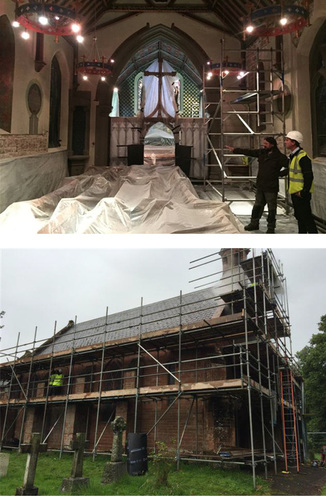
Warwick Bridge Church Open Day Sat 5 Nov
Built in 1841, Warwick Bridge is a unique surviving example of a small English parish church. Although it received remedial renovation over the years, urgent repairs became essential to stop the disintegration of lead, slate and stonework, and problems caused by the ingress of water. With funding from the Heritage Lottery Fund, work began to preserve the fabric of the church and safeguard it for future generations. The bellcote, roof and stonework have now been superbly restored and damp decaying plasterwork on the interior has been replaced. All are invited to come and see what it looks like and learn about the next phase of restorations. Light snacks including coffee and wine will be available. Presentations on restoration work are at 1 and 2, with guided tours by the architect to follow at 1:30 and 2:30. For further information phone Ged Acton 07936 135834.
Built in 1841, Warwick Bridge is a unique surviving example of a small English parish church. Although it received remedial renovation over the years, urgent repairs became essential to stop the disintegration of lead, slate and stonework, and problems caused by the ingress of water. With funding from the Heritage Lottery Fund, work began to preserve the fabric of the church and safeguard it for future generations. The bellcote, roof and stonework have now been superbly restored and damp decaying plasterwork on the interior has been replaced. All are invited to come and see what it looks like and learn about the next phase of restorations. Light snacks including coffee and wine will be available. Presentations on restoration work are at 1 and 2, with guided tours by the architect to follow at 1:30 and 2:30. For further information phone Ged Acton 07936 135834.
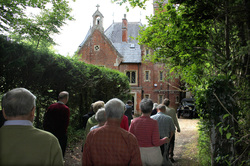
Reminiscing on this year's Study Tour
Photos and a summary of events have just been posted for this year’s Study Tour to explore the Gothic Revival in Hampshire and Wiltshire in the south. From 18-21 August Dr James Jago of the University of York led participants to well-known sites including, as a special last-minute addition, a trip to St Marie's Grange, Pugin's first home, seen here. See more HERE.
Photos and a summary of events have just been posted for this year’s Study Tour to explore the Gothic Revival in Hampshire and Wiltshire in the south. From 18-21 August Dr James Jago of the University of York led participants to well-known sites including, as a special last-minute addition, a trip to St Marie's Grange, Pugin's first home, seen here. See more HERE.
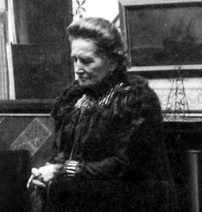
A new look at the life of Jane Pugin
The Society is delighted that Jane Franklin, great-great-granddaughter of Jane Pugin, has written an article for us on the often problematic life of her great-great grandmother. Thanks are due also for input from husband John Franklin.
As part of her article, Jane Franklin was also kind enough to submit new photos of Jane Pugin and family members, which are featured on Jane's page of the Pugin family tree.
Click HERE to view Jane Pugin's family tree with new photos.
We are always looking for input on the Pugin family tree - contact Catriona Blaker
The Society is delighted that Jane Franklin, great-great-granddaughter of Jane Pugin, has written an article for us on the often problematic life of her great-great grandmother. Thanks are due also for input from husband John Franklin.
As part of her article, Jane Franklin was also kind enough to submit new photos of Jane Pugin and family members, which are featured on Jane's page of the Pugin family tree.
Click HERE to view Jane Pugin's family tree with new photos.
We are always looking for input on the Pugin family tree - contact Catriona Blaker

Events announced for Pugin Week 2016
As part of the annual celebration of the life and works of AWN Pugin, St Augustine's, Ramsgate has released the schedule of events for this year's Pugin Week, September 7-14. View the full schedule HERE.
As part of the annual celebration of the life and works of AWN Pugin, St Augustine's, Ramsgate has released the schedule of events for this year's Pugin Week, September 7-14. View the full schedule HERE.
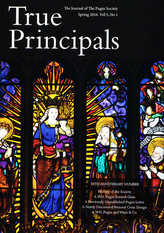
OH DEAR ... A MOST REGRETTABLE ERROR
Pugin's own spelling was at times shaky, but we do wonder what he would have made of the True Principals that appears on the front cover of the very elegant new issue of our Society's journal. We can only say that we are all only too well aware of this very unfortunate slip, and pray the indulgence of you, our members and readers. We must hope for better things (and proof reading) in the follow up number, and can but utter the words, as Pugin might have done, mea culpa, mea culpa.
Pugin's own spelling was at times shaky, but we do wonder what he would have made of the True Principals that appears on the front cover of the very elegant new issue of our Society's journal. We can only say that we are all only too well aware of this very unfortunate slip, and pray the indulgence of you, our members and readers. We must hope for better things (and proof reading) in the follow up number, and can but utter the words, as Pugin might have done, mea culpa, mea culpa.
Great News for Pugin's Woolwich Church - Heritage Lottery Fund supports renewal of 170 year-old roof and stonework
|
The Heritage Lottery Fund (HLF) has earmarked up to £250,000 for urgent roof renewal and restoration work for St. Peter the Apostle church in Woolwich. St Peter's is one of the oldest Catholic churches in London, designed by the famous promoter of the Victorian Gothic Revival, AWN Pugin and built in 1843. The church is a Grade 2 listed building, one of only three Pugin churches in London, but Historic England has assessed it as heritage at risk.
|
After 170 years, the slate roof has reached the end of its life, and much of the decorative stone-work has been eroded. In addition to these necessary repairs, an area of the church will be adapted to present an on-going series of free exhibitions, on themes developed in consultation with schools and other partners. It is planned to become a well-used resource for local schools and other groups pursuing interests in the Victorian period, Gothic revival architecture, art, Irish immigration, and local and military history. Works are due to start early next year and be finished by late Autumn 2017.
|
The Pugin Foundation finds a new home
After nine years dedicated to making Pugin's Australian heritage better known and more fully understood in its wider context, the Pugin Foundation has disbanded and its website has disappeared. Because the Foundation's website contained such a large amount of worthwhile scholarship on Pugin's activity not only in Australia but also worldwide, The Pugin Society has agreed to archive these sources for future use. |
To the former Friends of Pugin visiting us for the first time, welcome. And to those who have not yet encountered this wealth of information and scholarship, enjoy browsing this re-homed content, including the extensive Friends of Pugin Newsletters and associated image galleries, now available HERE.
The Church of St John the Baptist, Melton Mowbray, Leicestershire
St John's from the north-west and detail of the east window |
We gather that this attractive little church, built 1839 -1842, may be in danger of closing. It is not a Pugin church per se, but it has some interesting connections with A.W.N. Pugin. It was almost certainly designed by the Catholic architect and antiquarian Edward James Willson (1787-1854) of Lincoln, who was a friend and associate of Pugin’s father, Auguste Charles Pugin, and also of Pugin himself. Attributions to Pugin as architect have also been made, but these are not substantiated. However it is likely, given his close connections with Willson, that there was Pugin input with regard to the fittings. The church was funded by Mr John Exton of Eastwell Hall, for whom Willson had worked previously, and Father Tempest of Grantham. Both Exton and Fr Tempest appear as donors in the east window, which was very probably designed by Pugin and definitely made by the well known stained glass maker and artist Thomas Willement (1786-1871). The rood screen, with its rood and attendant figures of Mary and John the disciple, all very characteristic of Pugin, is no longer in situ, although it seems that the baptismal font, also thought to be a Pugin design, is in storage elsewhere; it could perhaps be returned to the church. Despite the loss of some its quality fittings St John’s remains an emotive and attractive witness to the history of Catholicism and Catholic church architecture in Leicestershire and is loved and appreciated by its parishioners and in regular use. We wish it well and hope that it will be able to find a way forward, perhaps assisted by a Friends association.
|
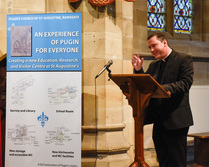
Marvellous news from St Augustine's Church Ramsgate
Pugin's world-renowned but until recently under promoted church has been awarded a major grant by the Heritage Lottery Fund. The amount given is 74% of total costings, which are £810,000. Additional works will bring the total spend up to £1 million. The funding has been given to create the Pugin and St Augustine Education, Research and Visitor Centre, within part of the existing fabric of the church. This will be a wonderful way to introduce Pugin - and St Augustine - to a much wider public, and we wish the project every success. For full details, please visit the Friends of St. Augustine HERE.
Update: "Restored – the treasure that Augustus Welby Pugin swore by," an excellent article by The Telegraph's Christopher Howse, discussing the changes at St Augustine's, can be found HERE.
Pugin's world-renowned but until recently under promoted church has been awarded a major grant by the Heritage Lottery Fund. The amount given is 74% of total costings, which are £810,000. Additional works will bring the total spend up to £1 million. The funding has been given to create the Pugin and St Augustine Education, Research and Visitor Centre, within part of the existing fabric of the church. This will be a wonderful way to introduce Pugin - and St Augustine - to a much wider public, and we wish the project every success. For full details, please visit the Friends of St. Augustine HERE.
Update: "Restored – the treasure that Augustus Welby Pugin swore by," an excellent article by The Telegraph's Christopher Howse, discussing the changes at St Augustine's, can be found HERE.
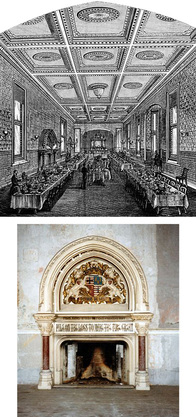 The Great Dining Hall shortly after construction (top), and the Gothic fireplace (bottom) before being boxed in.
The Great Dining Hall shortly after construction (top), and the Gothic fireplace (bottom) before being boxed in.
Save the Granville Hall
In Ramsgate the Augustus Pugin heritage is now in safe hands, with oustanding work being undertaken by Father Marcus Holden and team in St Augustine’s church and by the Landmark Trust at both the Grange and St Edward’s, the presbytery built by Pugin between the Grange and St Augustine’s in 1850.
But what about the Edward Pugin heritage in the town?
The Granville Hotel, on the East Cliff, was built by Edward Pugin in 1868 as eight terraced houses, which he soon converted into a hotel. This eventually became known as a very grand establishment indeed, with a splendid Lombardic tower (sadly reduced in height later and thereby losing its Italian character), elaborate reception rooms and bedroom suites with furniture and fittings also designed by Edward Pugin, and luxurious Turkish bath facilities. The hotel was added to by the architect J.T. Wimperis (1829 -1904), who also built the marina on the shore line below the hotel, and later, in 1900, the façade was given a makeover by the (far from Gothic Revivalist) architect, Horace Field (1861-1948). Used as a hospital for Canadian soldiers in World War One, bombed on one corner in World War Two with some additional and unneccessary post-war demolition subsequently, then partially rebuilt in the 1990s, and favoured by many famous celebrity visitors, the hotel (named after the popular second Earl Granville, twice Foreign Secretary and Lord Warden of the Cinque Ports) has had a significant architectural and social history. This building is important as a unique example of the secular/commercial-based, as opposed to ecclesiastical, work of Edward Pugin. It adds sigificantly to the remarkable collection of Pugin family sites generally in Ramsgate, and means a great deal to the inhabitants of the town.
In Ramsgate the Augustus Pugin heritage is now in safe hands, with oustanding work being undertaken by Father Marcus Holden and team in St Augustine’s church and by the Landmark Trust at both the Grange and St Edward’s, the presbytery built by Pugin between the Grange and St Augustine’s in 1850.
But what about the Edward Pugin heritage in the town?
The Granville Hotel, on the East Cliff, was built by Edward Pugin in 1868 as eight terraced houses, which he soon converted into a hotel. This eventually became known as a very grand establishment indeed, with a splendid Lombardic tower (sadly reduced in height later and thereby losing its Italian character), elaborate reception rooms and bedroom suites with furniture and fittings also designed by Edward Pugin, and luxurious Turkish bath facilities. The hotel was added to by the architect J.T. Wimperis (1829 -1904), who also built the marina on the shore line below the hotel, and later, in 1900, the façade was given a makeover by the (far from Gothic Revivalist) architect, Horace Field (1861-1948). Used as a hospital for Canadian soldiers in World War One, bombed on one corner in World War Two with some additional and unneccessary post-war demolition subsequently, then partially rebuilt in the 1990s, and favoured by many famous celebrity visitors, the hotel (named after the popular second Earl Granville, twice Foreign Secretary and Lord Warden of the Cinque Ports) has had a significant architectural and social history. This building is important as a unique example of the secular/commercial-based, as opposed to ecclesiastical, work of Edward Pugin. It adds sigificantly to the remarkable collection of Pugin family sites generally in Ramsgate, and means a great deal to the inhabitants of the town.
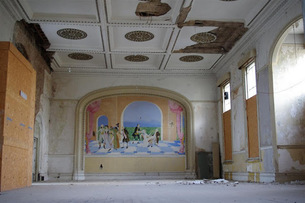 The Great Dining Hall today, showing signs of neglect.
The Great Dining Hall today, showing signs of neglect.
Currently, approximately two-thirds of the Granville now consists of flats, although up until the middle of the twentieth the imposing reception rooms were still being used for functions. The freehold of the whole building is now owned by property magnate Eliasz Englander, and the reception and bar area are subleased to Punch Taverns. The great dining hall, a pièce de resistance by Edward Pugin, as seen in the above photos and in its current state at the left, is forlorn indeed, virtually a hard hat area, and the surrounding rooms and bar area are very melancholy. The grand Gothic fireplace in the dining hall is boxed in and this whole section of the building is suffering from deep seated neglect. An alternative use could well be found, since Ramsgate has no designated hall for community and special functions, and this could be a perfect solution.
The Society, supported by the Ramsgate Society, and a recently formed Granville Hall committee, have submitted the building, with a particular focus on the subleased section, to the Victorian Society’s current list of England’s Ten Most Endangered Buildings. A site visit is being organised by our Chair Nick Dermott and others, to raise awareness in various quarters of the current condition of these fine rooms and further plans are in the pipeline, though comments and suggestions for a way forward are warmly welcomed.
The Society, supported by the Ramsgate Society, and a recently formed Granville Hall committee, have submitted the building, with a particular focus on the subleased section, to the Victorian Society’s current list of England’s Ten Most Endangered Buildings. A site visit is being organised by our Chair Nick Dermott and others, to raise awareness in various quarters of the current condition of these fine rooms and further plans are in the pipeline, though comments and suggestions for a way forward are warmly welcomed.
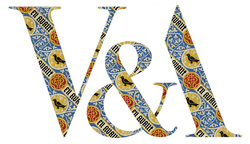
V&A to offer short course on Victorian Art and Design
The Victoria and Albert Museum presents the short 8 week course 'Pugin, Pre-Raphaelites and the Arts and Crafts' from January to March 2016. Those interested are sure to gain a unique insight into the rich and complex history of the period. This course will show how industrialisation, scientific developments and radical shifts in social and religious mores impacted on every aspect of Victorian life and the arts, as well as include in-depth investigations into influential figures such as Pugin. For more information, click HERE.
The Victoria and Albert Museum presents the short 8 week course 'Pugin, Pre-Raphaelites and the Arts and Crafts' from January to March 2016. Those interested are sure to gain a unique insight into the rich and complex history of the period. This course will show how industrialisation, scientific developments and radical shifts in social and religious mores impacted on every aspect of Victorian life and the arts, as well as include in-depth investigations into influential figures such as Pugin. For more information, click HERE.

A Good Start to the Year
The Pugin Society is delighted to announce that Society Chair and founding member Nick Dermott, RIBA, IHBC has been awarded the British Empire Medal in the New Year's Honours List for services to heritage and conservation in Thanet. This is a well-deserved and timely accolade, reflecting appreciation in government of aims central to the Pugin Society, and one which Augustus Pugin himself would have warmly applauded. Congratulations to Nick.
The Pugin Society is delighted to announce that Society Chair and founding member Nick Dermott, RIBA, IHBC has been awarded the British Empire Medal in the New Year's Honours List for services to heritage and conservation in Thanet. This is a well-deserved and timely accolade, reflecting appreciation in government of aims central to the Pugin Society, and one which Augustus Pugin himself would have warmly applauded. Congratulations to Nick.

Happy New Year from The Pugin Society
Nothing new to report, but this is perhaps a good opportunity to reflect on the past. Whether it was the midnight mass at St George’s Cathedral, Southwark, or the New Year’s Eve fireworks centered around Big Ben, Pugin has featured quite prominently as we end one year and begin the next. Although structures such as St George’s have changed considerably over time and may no longer reflect Pugin’s original vision, it is nonetheless a reminder that Pugin's spirit lives on in the fabric of his works – architectural or otherwise. We hope you enjoyed a joyous Christmas and wish you a peaceful and prosperous 2016.
Nothing new to report, but this is perhaps a good opportunity to reflect on the past. Whether it was the midnight mass at St George’s Cathedral, Southwark, or the New Year’s Eve fireworks centered around Big Ben, Pugin has featured quite prominently as we end one year and begin the next. Although structures such as St George’s have changed considerably over time and may no longer reflect Pugin’s original vision, it is nonetheless a reminder that Pugin's spirit lives on in the fabric of his works – architectural or otherwise. We hope you enjoyed a joyous Christmas and wish you a peaceful and prosperous 2016.
2015
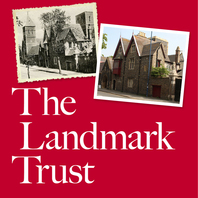
IMPORTANT - Help Still Needed for St Edward's Presbytery, Ramsgate
Donations are urgently needed by the Landmark Trust to complete the restoration of St Edward's Presbytery, now well underway. The work could be finished and the building open before Christmas, if only a further £138,000 can be found from additional generous donors. Everyone who supports the appeal will be given the first chance to see the completed project, at a special opening event for donors. To give a donation, of any size, and to find out more, click HERE.
Donations are urgently needed by the Landmark Trust to complete the restoration of St Edward's Presbytery, now well underway. The work could be finished and the building open before Christmas, if only a further £138,000 can be found from additional generous donors. Everyone who supports the appeal will be given the first chance to see the completed project, at a special opening event for donors. To give a donation, of any size, and to find out more, click HERE.
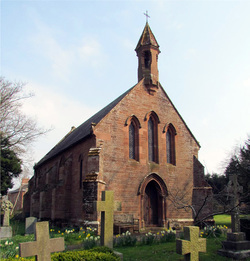
Our Lady & St Wilfrid’s, Warwick Bridge - End of Summer BBQ and Church Tours
The church of Our Lady & St Wilfrid's, Warwick Bridge (CA4 8RL) invites parishioners, local families & other interested parties to their End of Summer festivities on Sunday, 6th September from 12:30-3:00pm. The event will feature a "Bring and Burn" BBQ where you bring your own food and they supply the charcoal and grill. Guided tours of the church, designed by Augustus Pugin and completed in 1841, will be available and will give visitors a chance to find out about the parish's project to restore the church to its full glory. For further information contact Ged Acton at 07936 135834, and view the event poster HERE.
The church of Our Lady & St Wilfrid's, Warwick Bridge (CA4 8RL) invites parishioners, local families & other interested parties to their End of Summer festivities on Sunday, 6th September from 12:30-3:00pm. The event will feature a "Bring and Burn" BBQ where you bring your own food and they supply the charcoal and grill. Guided tours of the church, designed by Augustus Pugin and completed in 1841, will be available and will give visitors a chance to find out about the parish's project to restore the church to its full glory. For further information contact Ged Acton at 07936 135834, and view the event poster HERE.
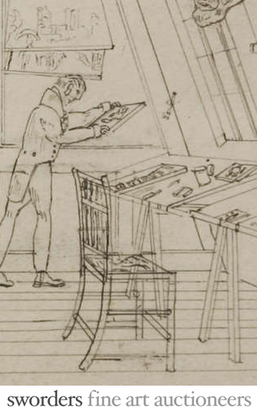
Sale of important AWN Pugin Memorabilia, Sworders Auctioneers Country House Sale
On Tuesday 15th September Sworders Auctioneers in Essex (CM24 8GE) will be auctioning several examples of Pugin memorabilia. Among the items for sale are a sketch by Pugin’s father, Augustus Charles, with possible additions by AWN, of the office at Store Street, 1821, representing the architectural studios of his father (detail at left); a brass altar vase, almost certainly used by Pugin in his private chapel at The Grange; a charming watercolour sketch by AWN, aged 13; a silver-plated candlestick designed by Pugin, for his own use at The Grange; and 5 silhouettes of the Pugin family, including what is believed to be the only known likeness of Catherine, his mother and of AWN, aged 7. Also included (Lot 230) is an important pamphlet published by Edward Pugin, Who was the Art Architect of the Houses of Parliament? Don't miss this opportunity to purchase, or to look at the on-line catalogue. click HERE for full details.
On Tuesday 15th September Sworders Auctioneers in Essex (CM24 8GE) will be auctioning several examples of Pugin memorabilia. Among the items for sale are a sketch by Pugin’s father, Augustus Charles, with possible additions by AWN, of the office at Store Street, 1821, representing the architectural studios of his father (detail at left); a brass altar vase, almost certainly used by Pugin in his private chapel at The Grange; a charming watercolour sketch by AWN, aged 13; a silver-plated candlestick designed by Pugin, for his own use at The Grange; and 5 silhouettes of the Pugin family, including what is believed to be the only known likeness of Catherine, his mother and of AWN, aged 7. Also included (Lot 230) is an important pamphlet published by Edward Pugin, Who was the Art Architect of the Houses of Parliament? Don't miss this opportunity to purchase, or to look at the on-line catalogue. click HERE for full details.
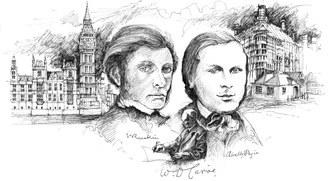
Rosemary Hill to present the inaugural lecture of the Mistley Caroe Gothic Society, 19 September, 6pm
The inaugural lecture for the Mistley Caroe Gothic Society will be presented by Rosemary Hill at 6pm on Saturday 19th September 2015 in William D Caroe’s beautiful Arts & Crafts Church Hall in Essex.
The Mistley Caroe Gothic Society was established to honour the work of architect W.D. Caroe and all things Gothic. Historian and scholar Rosemary Hill, author of the 2007 book God's Architect and the Building of Romantic Britain, will give the inaugural lecture for the Society, talking on the life and work of Pugin. The Caroe Singers will also be providing music and original songs (including their paean to Pugin, ‘God of Gothic’) before and after the lecture. Tickets to the lecture include a glass of wine and nibbles. For more information, view the press release HERE.
The inaugural lecture for the Mistley Caroe Gothic Society will be presented by Rosemary Hill at 6pm on Saturday 19th September 2015 in William D Caroe’s beautiful Arts & Crafts Church Hall in Essex.
The Mistley Caroe Gothic Society was established to honour the work of architect W.D. Caroe and all things Gothic. Historian and scholar Rosemary Hill, author of the 2007 book God's Architect and the Building of Romantic Britain, will give the inaugural lecture for the Society, talking on the life and work of Pugin. The Caroe Singers will also be providing music and original songs (including their paean to Pugin, ‘God of Gothic’) before and after the lecture. Tickets to the lecture include a glass of wine and nibbles. For more information, view the press release HERE.
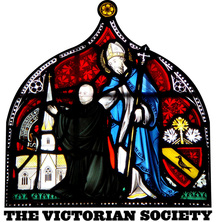
Saving A Century - A free photographic exhibition celebrating Victorian architecture
The Society is delighted that Saving a Century, the important Victorian Society travelling exhibition that uses archive photographs and material detailing the fight to save historic buildings and change public attitudes towards 19th century architecture, is to be on show in Pugin's own church of St Augustine's, Ramsgate. The exhibition runs from 1-31 August, daily from 10am-4pm with free admission. See more information on the Victorian Society flyer HERE.
The Society is delighted that Saving a Century, the important Victorian Society travelling exhibition that uses archive photographs and material detailing the fight to save historic buildings and change public attitudes towards 19th century architecture, is to be on show in Pugin's own church of St Augustine's, Ramsgate. The exhibition runs from 1-31 August, daily from 10am-4pm with free admission. See more information on the Victorian Society flyer HERE.

A Slice of Life: Bread Plate Exhibition features Pugin designs
From 9th May to 15th August 2015, The Nicholson Museum and Art Gallery in Leek, Staffordshire, presents an exhibition featuring a range of bread plates from 1845 to the commencement of the Second World War, collected over a period of time by Margaret Adams. It includes two Pugin bread plates, and other pieces showing the Pugin influence, plus much more, and will be an interesting comment on industrial design and aspects of social history in pre sliced loaf days. Read more HERE.
From 9th May to 15th August 2015, The Nicholson Museum and Art Gallery in Leek, Staffordshire, presents an exhibition featuring a range of bread plates from 1845 to the commencement of the Second World War, collected over a period of time by Margaret Adams. It includes two Pugin bread plates, and other pieces showing the Pugin influence, plus much more, and will be an interesting comment on industrial design and aspects of social history in pre sliced loaf days. Read more HERE.

Architect-Designers: From Pugin to Voysey, at the Fine Art Society, New Bond Street, London, 3 -25 June 2015
This is the seventh and last sale of work from the outstanding collections of John Scott, and will include important pieces by both Augustus and Edward Pugin plus work by other significant nineteenth century designers. All details from the Fine Art Society. Read more HERE.
This is the seventh and last sale of work from the outstanding collections of John Scott, and will include important pieces by both Augustus and Edward Pugin plus work by other significant nineteenth century designers. All details from the Fine Art Society. Read more HERE.
2014
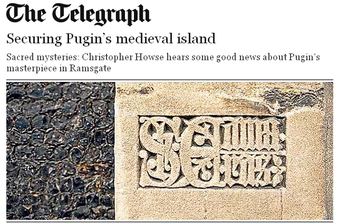
Pugin's presbytery in Ramsgate to be restored
After years of neglect, Pugin's home (the Grange) and his church of St. Augustine have both undergone extensive restoration efforts. However the presbytery, or priest's house, has not yet received any attention. The Telegraph reports that the Landmark Trust is to restore the presbytery if they can raise £671,000. The Pugin Society wishes the Landmark Trust the best of luck in their endeavour. Read the article HERE.
After years of neglect, Pugin's home (the Grange) and his church of St. Augustine have both undergone extensive restoration efforts. However the presbytery, or priest's house, has not yet received any attention. The Telegraph reports that the Landmark Trust is to restore the presbytery if they can raise £671,000. The Pugin Society wishes the Landmark Trust the best of luck in their endeavour. Read the article HERE.
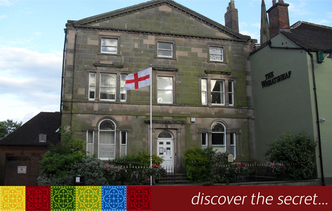
John M. Smith updates on the Cheadle Discovery and Visitor Centre
The Cheadle Discovery and Visitor Centre is the successor of the Pugin Centre of 2012. The building properly known as Lulworth House is a Victorian building which was the home and surgery of successive surgeons and the town’s police station until it was bought by the Bagnall family about a year before the celebrations for the 200th anniversary of the birth of AWN Pugin. When UVNS (Urban Vision North Staffs) were looking for a suitable venue for the celebrations the owner rented the building to them as a very substantial Heritage Lottery Fund grant funded the year’s activities.
In 2013 a very small group of volunteers, some of whom had volunteered during 2012 became determined to both continue presenting the Pugin heritage at the centre and provide a venue for a continued celebration of Cheadle’s history, geography, geology, natural history; pastimes and interests.We have now completed one year of events both about the town itself. We have held exhibitions on the Cheadle coalfield, workhouse, tape mills, transport by road and rail and local wildlife.
On the Pugin front we have conducted regular tours of St Giles and have provided information about St Joseph’s, Uttoxeter, Cotton College and church (both, sadly, in disrepair), St John’s Hospital, Castle and Alton Towers. We are able to book visiting groups of up to 50 for luncheon or tea in the town, as 2012, or provide coffee/tea and cake as required.
The Cheadle Discovery and Visitor Centre is the successor of the Pugin Centre of 2012. The building properly known as Lulworth House is a Victorian building which was the home and surgery of successive surgeons and the town’s police station until it was bought by the Bagnall family about a year before the celebrations for the 200th anniversary of the birth of AWN Pugin. When UVNS (Urban Vision North Staffs) were looking for a suitable venue for the celebrations the owner rented the building to them as a very substantial Heritage Lottery Fund grant funded the year’s activities.
In 2013 a very small group of volunteers, some of whom had volunteered during 2012 became determined to both continue presenting the Pugin heritage at the centre and provide a venue for a continued celebration of Cheadle’s history, geography, geology, natural history; pastimes and interests.We have now completed one year of events both about the town itself. We have held exhibitions on the Cheadle coalfield, workhouse, tape mills, transport by road and rail and local wildlife.
On the Pugin front we have conducted regular tours of St Giles and have provided information about St Joseph’s, Uttoxeter, Cotton College and church (both, sadly, in disrepair), St John’s Hospital, Castle and Alton Towers. We are able to book visiting groups of up to 50 for luncheon or tea in the town, as 2012, or provide coffee/tea and cake as required.
|
The centre has two rooms one of which is named the Pugin and Hardman Room. As long as we exist Neil Phillips of the Hardman Company will provide us with a rolling programme of artefacts. Currently we have a full size figure of Pugin, linenfold panelling of various patterns, sections of brass screens and hinges from the Palace of Westminster, processional candle holders and tiles all designed by AWN Pugin.
Above left: tile with Pugin design; above right: wax mould for an eagle. |
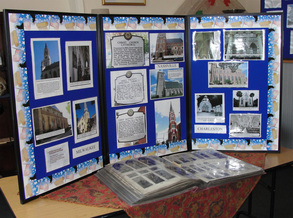 Part of the American Gothic display
Part of the American Gothic display
It is our intention to host exhibitions in this room on all Pugin related subjects. It is for this reason that our current Pugin exhibition is about the gothic idiom mainly in the United States: American Gothic. While the personal contact was minimal with Pugin never visiting and Edward only for a short time before his death the influence of Pugin and the other gothic revivalists is unmistakeable particularly in the Episcopalian churches. Our next Pugin related exhibition is to be: Pugin and Australian Gothic and aims to show the diligence of Pugin in helping Bishop Willson set up a diocese in Tasmania with every thing necessary for a catholic from cradle to gravestone. It aims also to highlight the work of William Wardell variously described as following or complementing Pugin in Australia.
Each of the main buildings of Pugin-land will feature as one-building exhibitions in future and it is hoped work by Bodley, Street, the Gilbert Scotts and others will feature in exhibitions on Victorian Gothic. We have still, to capitalise on the Hardman Collection of photographs and glass photographic plates we have in storage. It is our plan via Neil Phillips and Michael J Fisher to submit a bid to the Arts Council to archive this material and to display it as part of our exhibitions in future.
Like all small heritage ventures our future is bound to be uncertain unless what we do is extensively used by the town and by visitors like members of the Pugin Society who value our architectural heritage. We invite the society and its members to help us in the task of providing an authentic insight into Pugin’s work in Staffordshire. We can, in our turn, assure you of our commitment to direct visitors to the very important proposals to create the Pugin and St Augustine Research, Archive and Visitor Centre in Ramsgate and to inform them about the Pugin Society.
Each of the main buildings of Pugin-land will feature as one-building exhibitions in future and it is hoped work by Bodley, Street, the Gilbert Scotts and others will feature in exhibitions on Victorian Gothic. We have still, to capitalise on the Hardman Collection of photographs and glass photographic plates we have in storage. It is our plan via Neil Phillips and Michael J Fisher to submit a bid to the Arts Council to archive this material and to display it as part of our exhibitions in future.
Like all small heritage ventures our future is bound to be uncertain unless what we do is extensively used by the town and by visitors like members of the Pugin Society who value our architectural heritage. We invite the society and its members to help us in the task of providing an authentic insight into Pugin’s work in Staffordshire. We can, in our turn, assure you of our commitment to direct visitors to the very important proposals to create the Pugin and St Augustine Research, Archive and Visitor Centre in Ramsgate and to inform them about the Pugin Society.
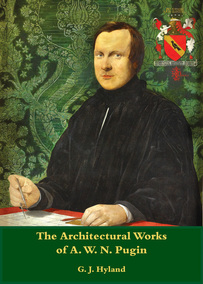
Spire Books releases G. J. Hyland's The Architectural Works of A.W.N. Pugin
In this groundbreaking comprehensive study Gerard Hyland identifies over 290 of Pugin's executed works and at least 84 unexecuted designs spread over five countries and two continents. The entries comprise an architectural description plus information about patronage, later building history and a list of sources. Dr Hyland's new book is his tribute to one of our greatest and most influential architects. It is enhanced by illustrations of key buildings, nearly all in colour. Spire Books is offering this text at pre-publication pricing of £26.95. Download the order form HERE.
In this groundbreaking comprehensive study Gerard Hyland identifies over 290 of Pugin's executed works and at least 84 unexecuted designs spread over five countries and two continents. The entries comprise an architectural description plus information about patronage, later building history and a list of sources. Dr Hyland's new book is his tribute to one of our greatest and most influential architects. It is enhanced by illustrations of key buildings, nearly all in colour. Spire Books is offering this text at pre-publication pricing of £26.95. Download the order form HERE.
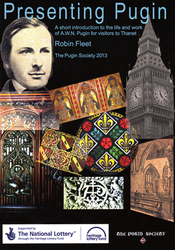
New Society Publication available: Presenting Pugin
The Pugin Society is pleased to announce the publication of Presenting Pugin: A short introduction to the life and work of A.W.N. Pugin for visitors to Thanet. Written by Pugin Society member Robin Fleet, it has been produced as one of four projects undertaken by the Society as the result of funding last year (2012, Pugin's Bicentenary) from the Heritage Lottery Fund to further knowledge of Pugin in the South East. This book is simply and clearly written and we hope visitors to East Kent, and particularly Ramsgate, will find it helpful and accessible. Find out more HERE and order the book HERE.
The Pugin Society is pleased to announce the publication of Presenting Pugin: A short introduction to the life and work of A.W.N. Pugin for visitors to Thanet. Written by Pugin Society member Robin Fleet, it has been produced as one of four projects undertaken by the Society as the result of funding last year (2012, Pugin's Bicentenary) from the Heritage Lottery Fund to further knowledge of Pugin in the South East. This book is simply and clearly written and we hope visitors to East Kent, and particularly Ramsgate, will find it helpful and accessible. Find out more HERE and order the book HERE.
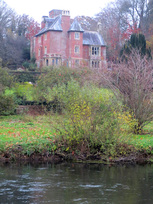
An Unexpected Vista offers a Stunning View
St Marie's Grange, Alderbury, near Salisbury. An atmospheric view recently captured by Professor Julia Twigg, committee member and events organiser, whilst staying nearby. St Marie's Grange, lived in by Augustus Pugin until 1837, was built by him in 1835. It is interesting to compare it with his later house, The Grange, Ramsgate (1843-1844), by which time his approach to domestic architecture had matured and developed along rather different lines.
St Marie's Grange, Alderbury, near Salisbury. An atmospheric view recently captured by Professor Julia Twigg, committee member and events organiser, whilst staying nearby. St Marie's Grange, lived in by Augustus Pugin until 1837, was built by him in 1835. It is interesting to compare it with his later house, The Grange, Ramsgate (1843-1844), by which time his approach to domestic architecture had matured and developed along rather different lines.
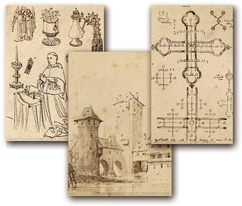
Wonderful Pugin drawings for all to share
A set of 500 photographs of sketches by Pugin were recently discovered in the Cadbury Research Library: Special Collections at the University of Birmingham. Taken in 1865 by the photographer Stephen Ayling, these drawings include cathedrals, ecclesiastical interiors, metalwork, furniture and architectural details. This splendid collection of drawings is available to view HERE. You will not be disappointed.
A set of 500 photographs of sketches by Pugin were recently discovered in the Cadbury Research Library: Special Collections at the University of Birmingham. Taken in 1865 by the photographer Stephen Ayling, these drawings include cathedrals, ecclesiastical interiors, metalwork, furniture and architectural details. This splendid collection of drawings is available to view HERE. You will not be disappointed.

Excitement grows with the approach of Pugin Week 11-16 September 2014
For full details about Pugin Week watch www.augustinefriends.co.uk and note particularly the forthcoming lecture by Father Marcus Holden on Ramsgate and Pugin on Monday 15th September at 7.00 in St Augustine's church, Ramsgate. Tours up the tower are also offered!
The Grange, owned by the Landmark trust, will be open as part of Heritage Open Days from Friday September 12th through to September 16th. Opening times are 10-4 each day, except for Tuesday 16th, 10-1. Don't miss all these opportunities to find out a great deal more about Pugin and his life in Thanet.
For full details about Pugin Week watch www.augustinefriends.co.uk and note particularly the forthcoming lecture by Father Marcus Holden on Ramsgate and Pugin on Monday 15th September at 7.00 in St Augustine's church, Ramsgate. Tours up the tower are also offered!
The Grange, owned by the Landmark trust, will be open as part of Heritage Open Days from Friday September 12th through to September 16th. Opening times are 10-4 each day, except for Tuesday 16th, 10-1. Don't miss all these opportunities to find out a great deal more about Pugin and his life in Thanet.
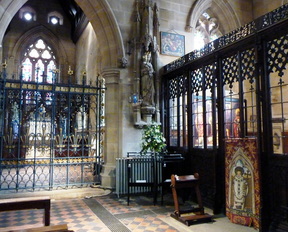
Further Good News for Pugin's church of St Augustine's, Ramsgate
On Monday 11th November 2014 it was announced that the Heritage Lottery Fund is backing a first round application by the Friends of St Augustine to eventually implement a unique Education, Research and Visitor Centre in St Augustine's church. The church has received £82,100 to help plans to progress towards a full application of £800,000 to create the Centre. To receive support at this stage from the HLF is tremendously encouraging, and the scheme would be enormously valuable in making Pugin, St Augustine's and the ecclesiastical history of Thanet and East Kent better known. En Avant, or Forward, indeed, in the words of Pugin's motto.
On Monday 11th November 2014 it was announced that the Heritage Lottery Fund is backing a first round application by the Friends of St Augustine to eventually implement a unique Education, Research and Visitor Centre in St Augustine's church. The church has received £82,100 to help plans to progress towards a full application of £800,000 to create the Centre. To receive support at this stage from the HLF is tremendously encouraging, and the scheme would be enormously valuable in making Pugin, St Augustine's and the ecclesiastical history of Thanet and East Kent better known. En Avant, or Forward, indeed, in the words of Pugin's motto.
2013
|
Heritage Lottery Fund supports the Rescue of St Marie's, Widnes
Congratulations to all those involved with the rescue of St Marie's RC church, Widnes, Cheshire, designed by Edward Pugin (1834-1875) in 1864/5, but with various later additions, and listed Grade II. When this church closed in 2007 its future looked precarious, and the Society reported on the process of applying to the Heritage Lottery Fund to secure funds to reopen St Maries Church, Widnes for community purposes. We are happy to report that, due to local endeavour, and particularly to Halton and St Helens Voluntary and Community Action group, it has now received a Heritage Lottery Fund grant of £1.6m and will be restored as a community centre. We assisted in supporting this application to the HLF and are delighted to see this happy outcome. |
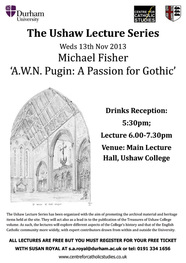
Michael Fisher to give lecture 'A.W.N. Pugin: A Passion for Gothic' at Ushaw College
Pugin enthusiasts and Society members living in the North-East may well be interested in this lecture by Pugin expert Michael Fisher, to be held in one of the remarkable Ushaw College buildings. The talk, titled 'A.W.N. Pugin: A Passion for Gothic', will take place on Wednesday, 13th November. A drinks reception takes place at 5:30pm with the lecture to follow at 6:00pm. The lecture is free but you must reserve your ticket via email. Click on the image to the right to view larger, or download a PDF of the flyer HERE.
Pugin enthusiasts and Society members living in the North-East may well be interested in this lecture by Pugin expert Michael Fisher, to be held in one of the remarkable Ushaw College buildings. The talk, titled 'A.W.N. Pugin: A Passion for Gothic', will take place on Wednesday, 13th November. A drinks reception takes place at 5:30pm with the lecture to follow at 6:00pm. The lecture is free but you must reserve your ticket via email. Click on the image to the right to view larger, or download a PDF of the flyer HERE.
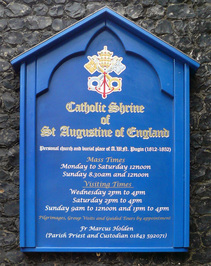
Glad Tidings for A.W.N. Pugin's St Augustine's Church, Ramsgate
We are delighted that restoration work is now in progress on the church, and also that it has been officially designated a Catholic shrine to St Augustine of England by the Catholic Archbishop of Southwark. How pleased Pugin would have been. This church, arguably the most significant of all Pugin's ecclesiastical buildings, was the one which meant more to him than any other. He designed it exactly as he wished, with no interference from outside parties, and paid for it all out of his own pocket. It was a thank offering to his new-found Catholic faith, and is an embodiment of all his architectural and artistic beliefs and a key symbol of the Gothic and Catholic Revivals of the nineteenth century. Over the last several years or so its future has been uncertain, but now its restoration is proceeding with confidence, under the direction of its enthusiastic priest, Father Marcus Holden, and supported by its many admirers. In the words of Pugin's own motto, En Avant (forward)! To support the church fabric repairs and view a large collection of photographs, see the website of Friends of St Augustine's Church HERE.
We are delighted that restoration work is now in progress on the church, and also that it has been officially designated a Catholic shrine to St Augustine of England by the Catholic Archbishop of Southwark. How pleased Pugin would have been. This church, arguably the most significant of all Pugin's ecclesiastical buildings, was the one which meant more to him than any other. He designed it exactly as he wished, with no interference from outside parties, and paid for it all out of his own pocket. It was a thank offering to his new-found Catholic faith, and is an embodiment of all his architectural and artistic beliefs and a key symbol of the Gothic and Catholic Revivals of the nineteenth century. Over the last several years or so its future has been uncertain, but now its restoration is proceeding with confidence, under the direction of its enthusiastic priest, Father Marcus Holden, and supported by its many admirers. In the words of Pugin's own motto, En Avant (forward)! To support the church fabric repairs and view a large collection of photographs, see the website of Friends of St Augustine's Church HERE.
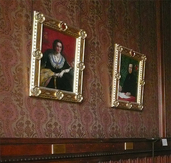
Houses of Parliament Summer Tours
All admirers of Pugin will be pleased to see that the Houses of Parliament are offering some excellent tours, some including tea in the Pugin Room (not always visited on a standard tour), where the famous portraits of Augustus Pugin, and his third wife Jane Knill can be seen. For more details, and to visit, click HERE.
All admirers of Pugin will be pleased to see that the Houses of Parliament are offering some excellent tours, some including tea in the Pugin Room (not always visited on a standard tour), where the famous portraits of Augustus Pugin, and his third wife Jane Knill can be seen. For more details, and to visit, click HERE.
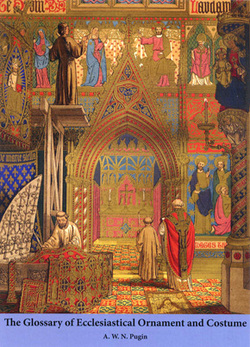
Important new Pugin publication from Spire Books
The Glossary of Ecclesiastical Ornament and Costume is Pugin's largest and most magnificent book. He intended that his two Dublin Review articles of 1842 would be accompanied by a third dealing with ornament and decoration. However, this developed into a grand survey of church ornaments, vessels and vestments which are dealt with alphabetically, including long forgotten ones he hoped to revive. This masterly survey reveals the extraordinary breadth and depth of Pugin's researches. Its chief glory lies in 73 superb chromolithographs showing 'correctly' vested clergy and a wide range of patterns for embroidery, monograms and emblems. 'Never - in modern days at least - were illuminations more exquisite, concluded The Ecclesiologist (1844). Even today, Pugin's Glossary remains a locus classicus for the church furnishing. The edition reproduced is that of 1846, with an introduction by Michael Fisher. Click HERE for ordering information.
The Glossary of Ecclesiastical Ornament and Costume is Pugin's largest and most magnificent book. He intended that his two Dublin Review articles of 1842 would be accompanied by a third dealing with ornament and decoration. However, this developed into a grand survey of church ornaments, vessels and vestments which are dealt with alphabetically, including long forgotten ones he hoped to revive. This masterly survey reveals the extraordinary breadth and depth of Pugin's researches. Its chief glory lies in 73 superb chromolithographs showing 'correctly' vested clergy and a wide range of patterns for embroidery, monograms and emblems. 'Never - in modern days at least - were illuminations more exquisite, concluded The Ecclesiologist (1844). Even today, Pugin's Glossary remains a locus classicus for the church furnishing. The edition reproduced is that of 1846, with an introduction by Michael Fisher. Click HERE for ordering information.
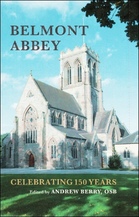
Edward Pugin at Belmont Abbey
The Society is very pleased to announce the publication of a new book about Edward Pugin's fine Belmont Abbey, in Herefordshire, Belmont Abbey, celebrating one hundred and fifty years, published by Gracewing, and edited by Dom Andrew Berry OSB. This book contains a chapter which will be of particular interest to members and all Pugin enthusiasts, by Dr Roderick O'Donnell, Pugin expert, with a special interest in Edward Pugin. He discusses the Pugin family contribution to Belmont in the chapter, 'The Pugins and the Belmont Abbey Church and Monastery; History and Architecture'. Click HERE to find out more.
The Society is very pleased to announce the publication of a new book about Edward Pugin's fine Belmont Abbey, in Herefordshire, Belmont Abbey, celebrating one hundred and fifty years, published by Gracewing, and edited by Dom Andrew Berry OSB. This book contains a chapter which will be of particular interest to members and all Pugin enthusiasts, by Dr Roderick O'Donnell, Pugin expert, with a special interest in Edward Pugin. He discusses the Pugin family contribution to Belmont in the chapter, 'The Pugins and the Belmont Abbey Church and Monastery; History and Architecture'. Click HERE to find out more.
|
Lottery bid for St Marie's Church (RC) Widnes, Cheshire
Halton and St Helens Voluntary and Community Action group (VCA), Merseyside, are currently in the process of applying to the Heritage Lottery Fund to secure funds to reopen St Maries Church, Widnes for community purposes, including a comprehensive heritage activity programme. This very interesting church, listed Grade II, was designed 1864/5 by Edward Pugin, with additional work by other members of the Pugin family. St Maries has been closed since 2007 and has become increasingly forlorn. This project has the full support from the Archdiocese, the current owner of the site, as well as the local authority. The organisation Pulse Regeneration is supporting VCA in the development of the project and the HLF application process. We wish this project the best of luck. |
2012

Pugin Goes Global
We are delighted to report the success of the recent stimulating conference New Directions in Gothic Revival Studies Worldwide, organised by the University of Kent in association with the Pugin Society. It was wonderful, and heart-warming, to learn of the huge influence across the globe of the work of Augustus Welby Pugin. Highlights included the excellent talk by celebrated Pugin biographer Rosemary Hill, in Ramsgate, and the launch of the fourth volume of Pugin's letters, all part of the remarkable magnum opus expertly edited by Dr Margaret Belcher. There was much more besides. The University of Leuven Press is currently considering a proposal to invite speakers at the conference to contribute to a book on the subject. We look forward to hearing more about this exciting possibility. |
Dr Margaret Belcher (right), editor of Pugin's letters, the fourth volume of which has just appeared, celebrates with Mrs Sarah Houle, President of the Pugin Society and great-great granddaughter of Augustus Pugin. |
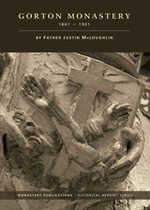
St Francis Gorton
Many Pugin family enthusiasts will be aware of the The Monastery of St. Francis and Gorton Trust, a charitable Trust, formed to save Edward Pugin's disused Franciscan Friary in Gorton, Manchester. The Trust has triumphantly succeeded in saving this building from demolition, and has recently established Monastery Publications. To look at these, and in particular at a new work on how 12 statues of Franciscan Saints were rescued from a Sothebys auction and returned to the building, click HERE.
Many Pugin family enthusiasts will be aware of the The Monastery of St. Francis and Gorton Trust, a charitable Trust, formed to save Edward Pugin's disused Franciscan Friary in Gorton, Manchester. The Trust has triumphantly succeeded in saving this building from demolition, and has recently established Monastery Publications. To look at these, and in particular at a new work on how 12 statues of Franciscan Saints were rescued from a Sothebys auction and returned to the building, click HERE.
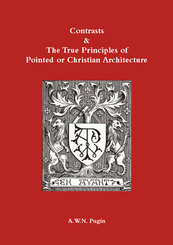
Pugin Works Reprinted
Another publication from the industrious Spire Books for 2012! A special production for this Bicentennial year, this reprint represents an excellent opportunity for all Pugin scholars and enthusiasts to buy in one volume Pugin's two most important works, Contrasts and The True Principles of Pointed or Christian Architecture. These two titles represent all that is most significant and enduring of Pugin's beliefs and theories, both architecturally speaking and more widely. They are ground-breaking manifestos, and surely a must for all afficionados. Click HERE for ordering information.
Another publication from the industrious Spire Books for 2012! A special production for this Bicentennial year, this reprint represents an excellent opportunity for all Pugin scholars and enthusiasts to buy in one volume Pugin's two most important works, Contrasts and The True Principles of Pointed or Christian Architecture. These two titles represent all that is most significant and enduring of Pugin's beliefs and theories, both architecturally speaking and more widely. They are ground-breaking manifestos, and surely a must for all afficionados. Click HERE for ordering information.
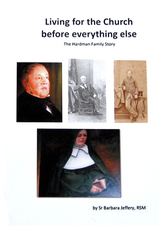
Hardmans of Birmingham
The Pugin Society is glad to be able to draw attention to the excellent and informative short book Living for the Church before Everything Else, written by Sister Barbara Jeffery, Archivist and Historian of the Religious Sisters of Mercy, about the Hardmans of Birmingham.
Sister Barbara writes: After spending eight years in St Mary's Convent, Handsworth I felt I had learnt a great deal about the Hardman family and thought it would be good to put them in context in their world. I was fascinated by the fact that many of the Hardman women went into religious orders of various sorts and the Hardman men continually supported the Catholic Church through its churches, schools and even cemeteries. They had their roots in Lancashire and became pillars of the society in which they were living. I wanted to show how it was possible for a family such as the Hardmans to support the Catholic Church as it found its feet gradually in the mid 19th century. I am sure their story could be multiplied many times over by other families in other areas who have been the backbone of the Catholic Church down through the ages.
Book printed by Parchments of Oxford, November 2010, 119 pages, colour illustrations throughout. Price £6.50 plus £1.50 P & P. Available for purchase from either The Archivist, Sisters of Mercy, Parkers Row, Bermondsey, London SE1 2DQ or The Archivist, St Mary's Convent, 98 Hunters Road, Handsworth, Birmingham, B19 1EB.
The Pugin Society is glad to be able to draw attention to the excellent and informative short book Living for the Church before Everything Else, written by Sister Barbara Jeffery, Archivist and Historian of the Religious Sisters of Mercy, about the Hardmans of Birmingham.
Sister Barbara writes: After spending eight years in St Mary's Convent, Handsworth I felt I had learnt a great deal about the Hardman family and thought it would be good to put them in context in their world. I was fascinated by the fact that many of the Hardman women went into religious orders of various sorts and the Hardman men continually supported the Catholic Church through its churches, schools and even cemeteries. They had their roots in Lancashire and became pillars of the society in which they were living. I wanted to show how it was possible for a family such as the Hardmans to support the Catholic Church as it found its feet gradually in the mid 19th century. I am sure their story could be multiplied many times over by other families in other areas who have been the backbone of the Catholic Church down through the ages.
Book printed by Parchments of Oxford, November 2010, 119 pages, colour illustrations throughout. Price £6.50 plus £1.50 P & P. Available for purchase from either The Archivist, Sisters of Mercy, Parkers Row, Bermondsey, London SE1 2DQ or The Archivist, St Mary's Convent, 98 Hunters Road, Handsworth, Birmingham, B19 1EB.
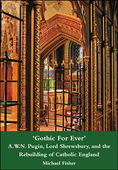
New Pugin Book - Gothic For Ever
In this Bicentenary year the Society is pleased indeed to be promoting a splendid and beautifully illustrated new book on Pugin by well-known Pugin expert Michael Fisher and published by Spire Books. Full details can be seen HERE.
In this Bicentenary year the Society is pleased indeed to be promoting a splendid and beautifully illustrated new book on Pugin by well-known Pugin expert Michael Fisher and published by Spire Books. Full details can be seen HERE.














































